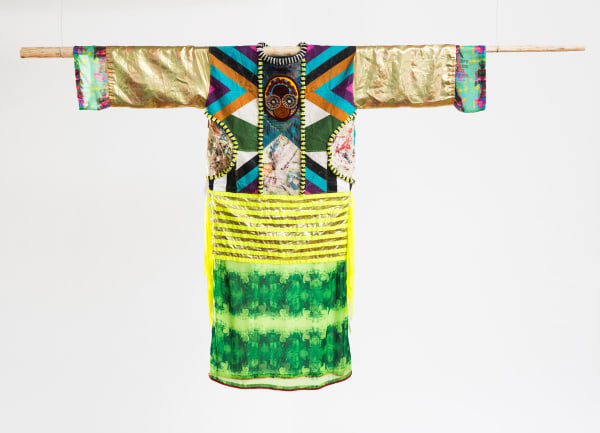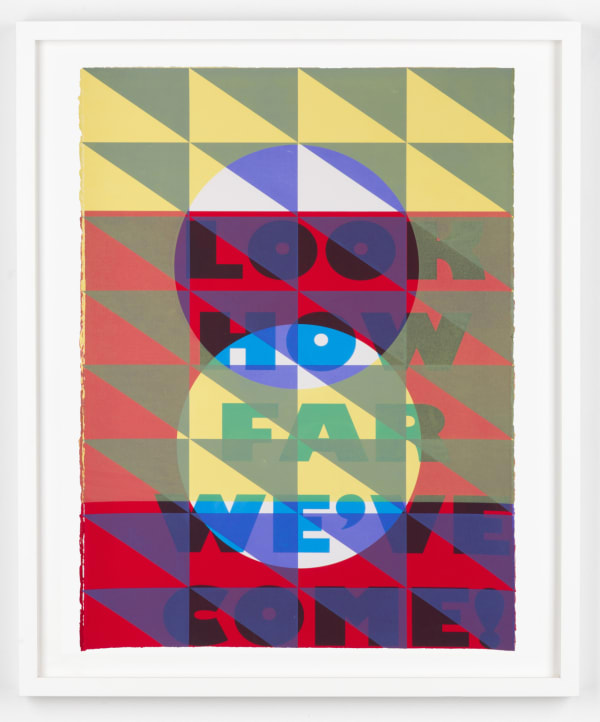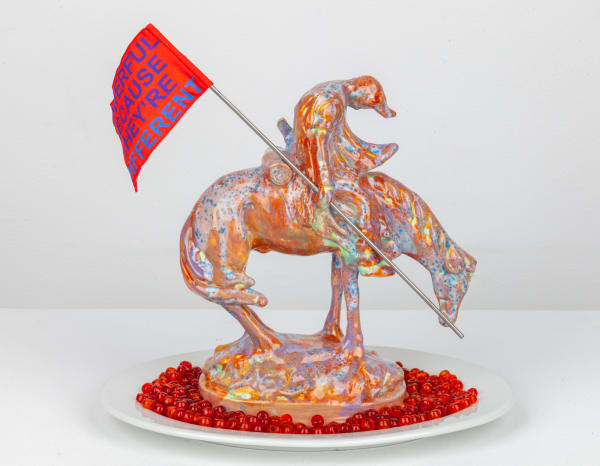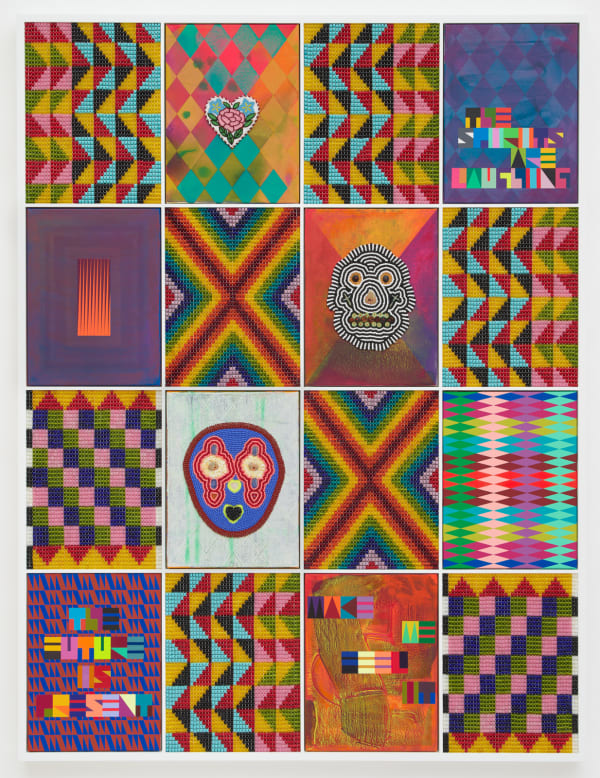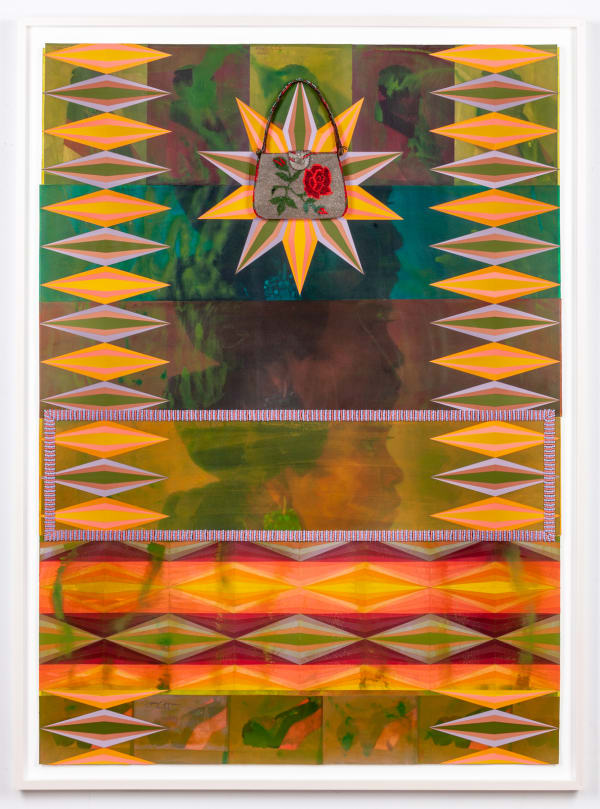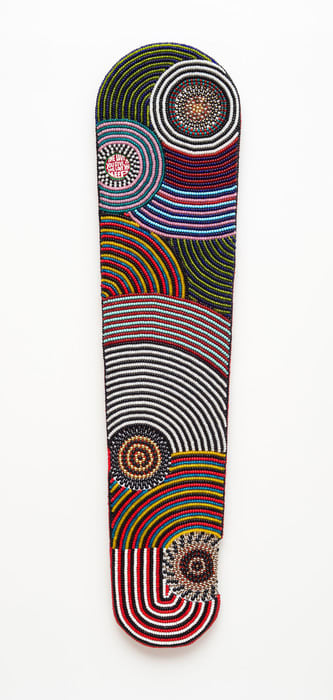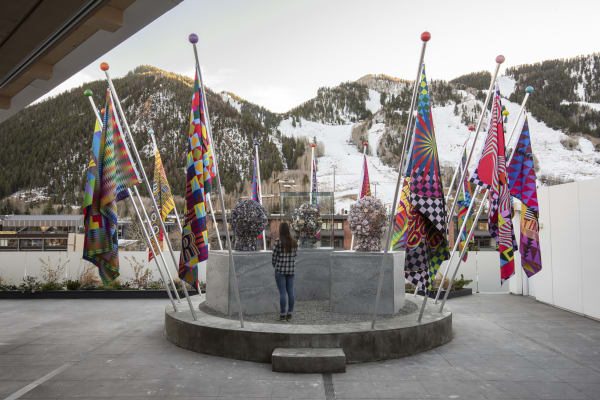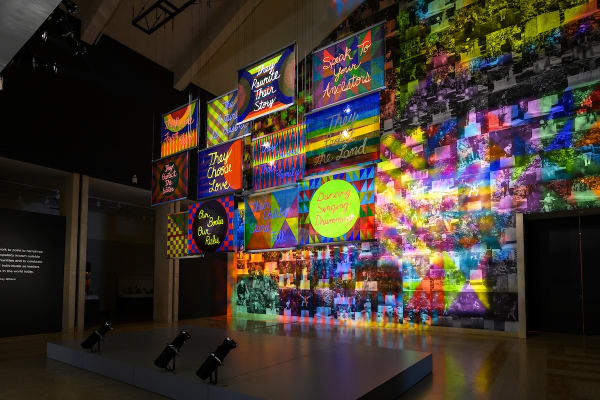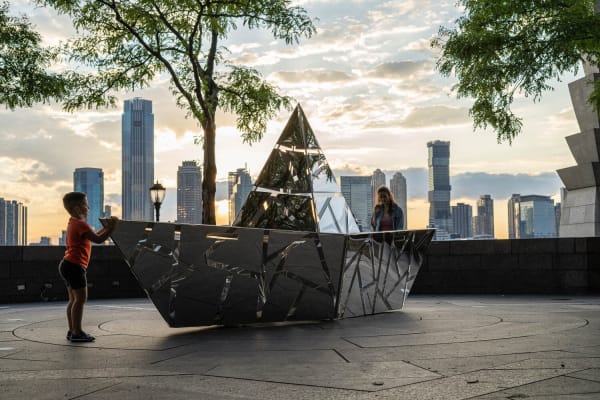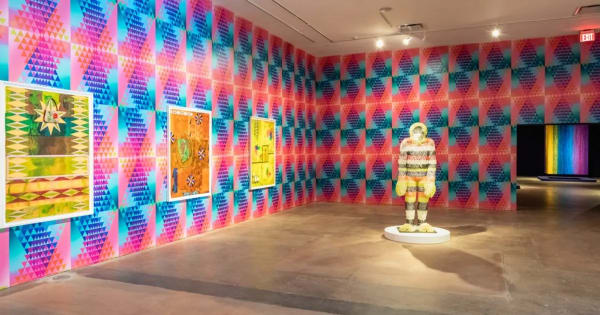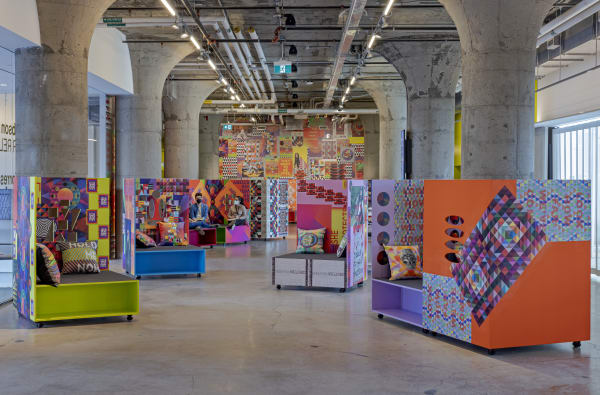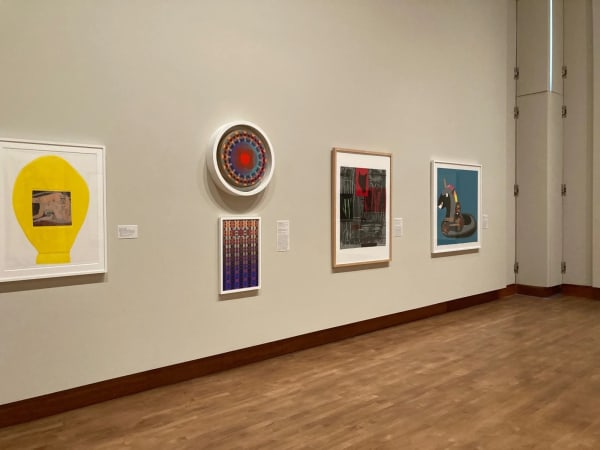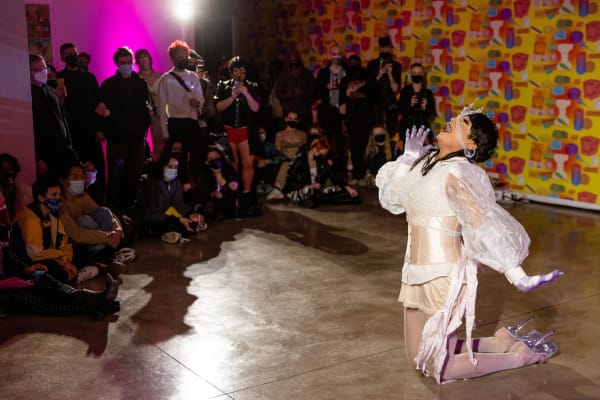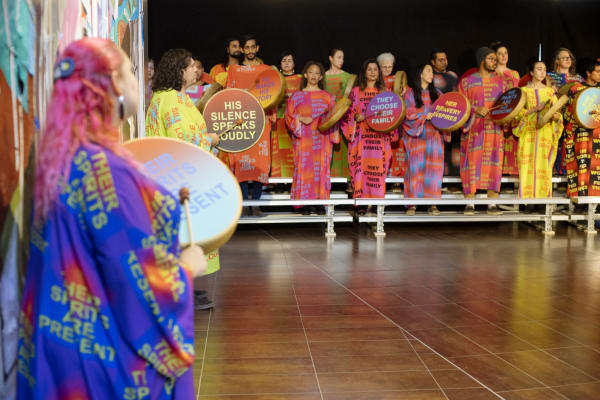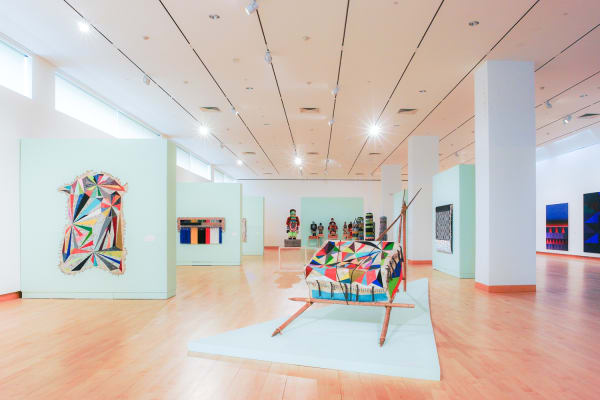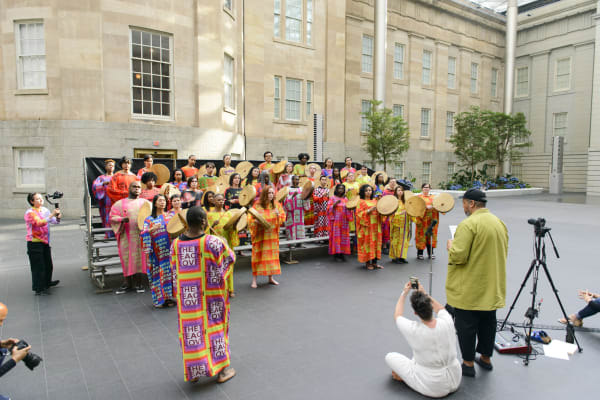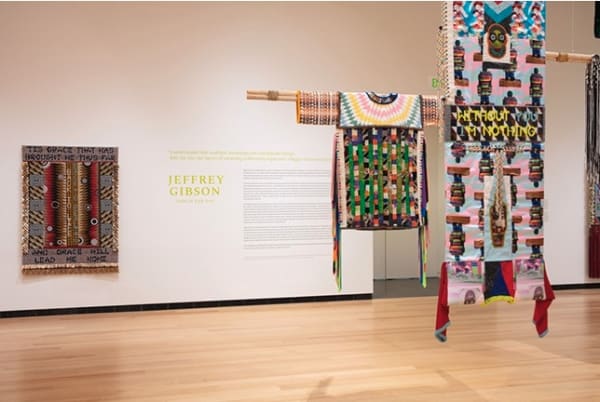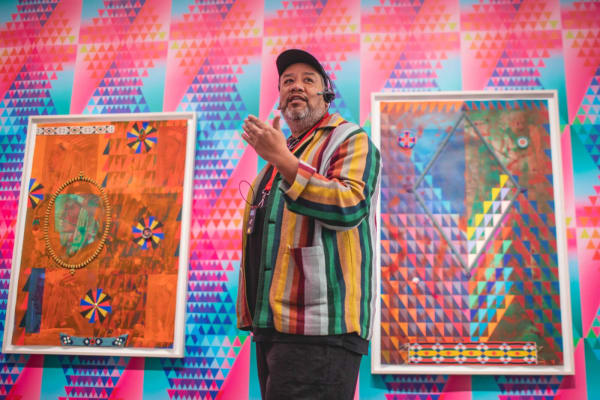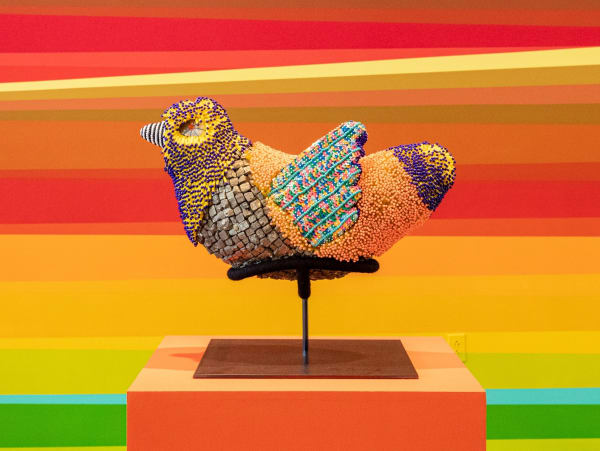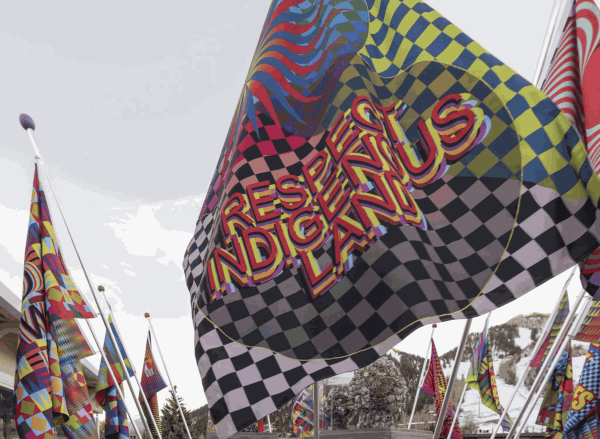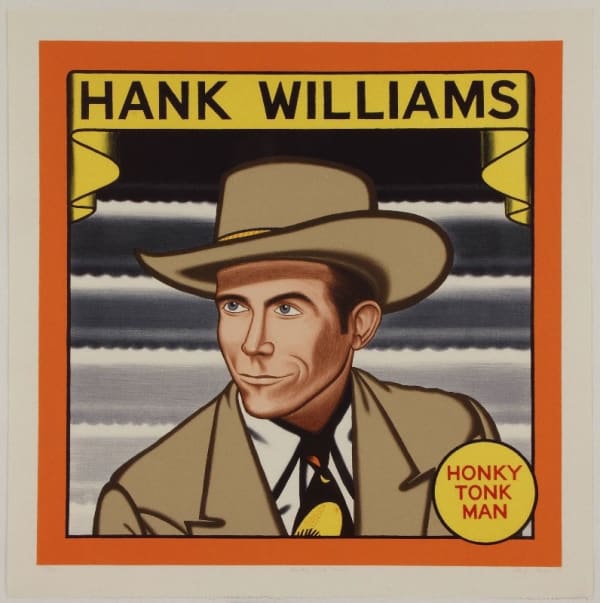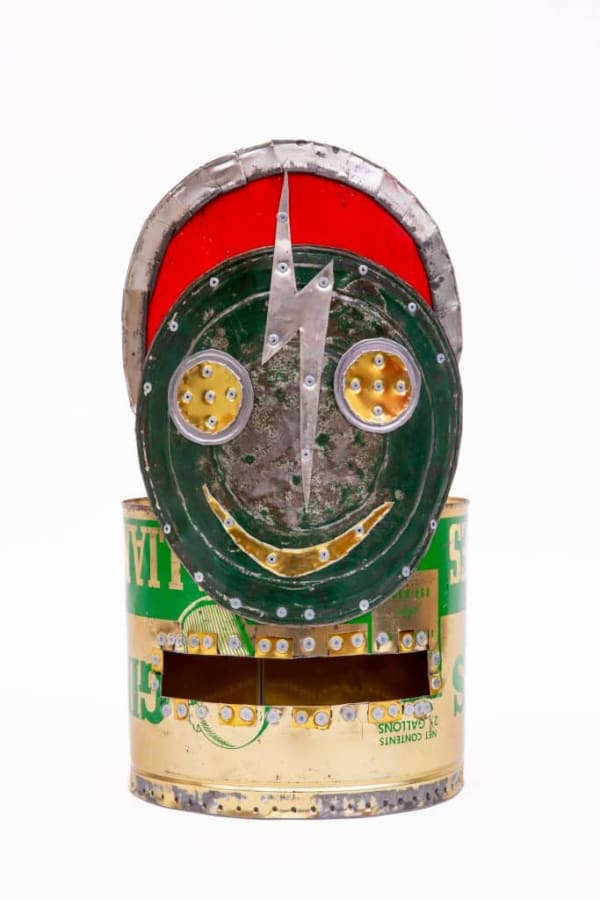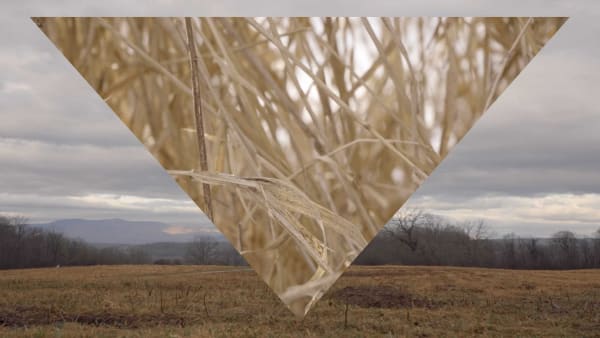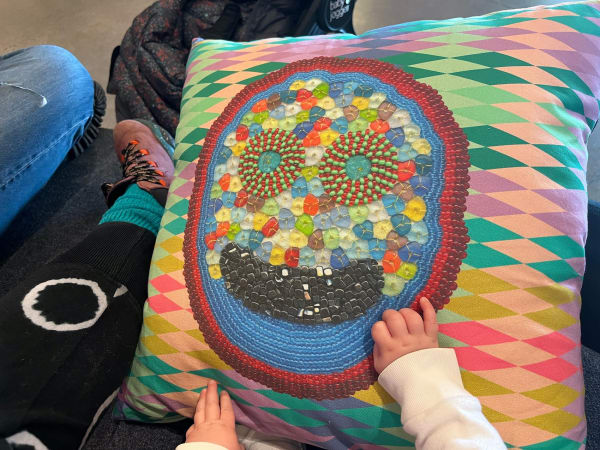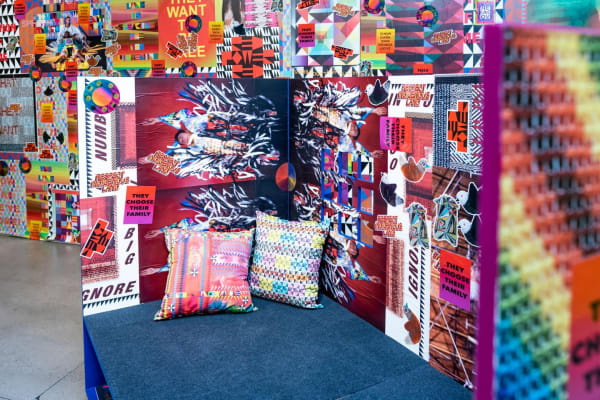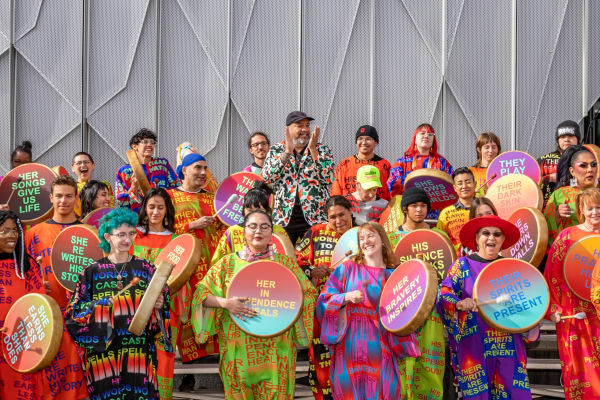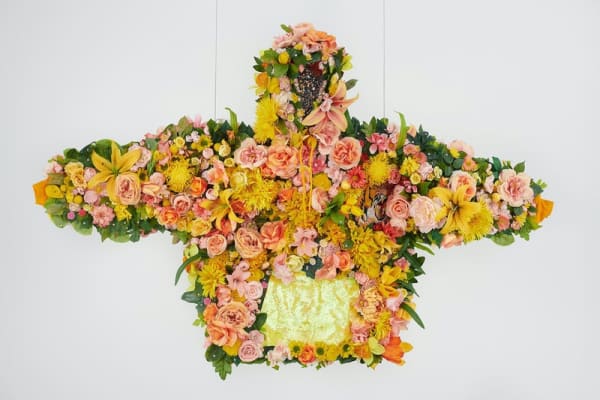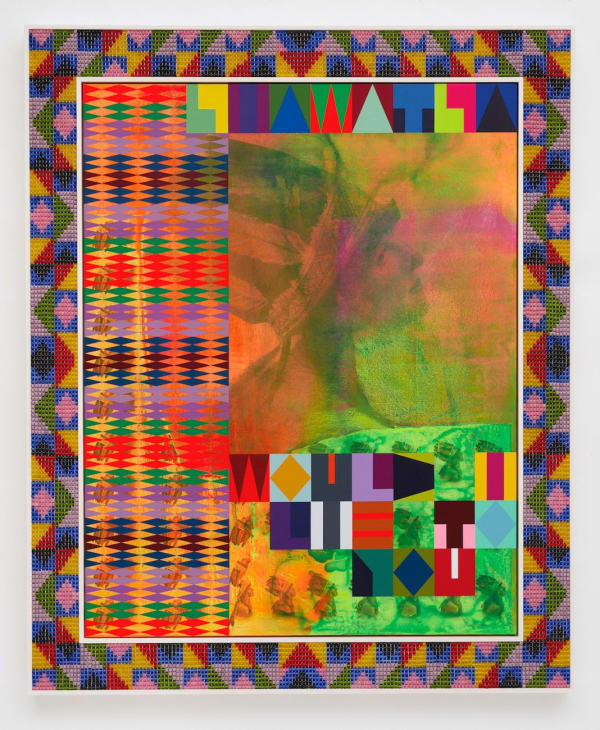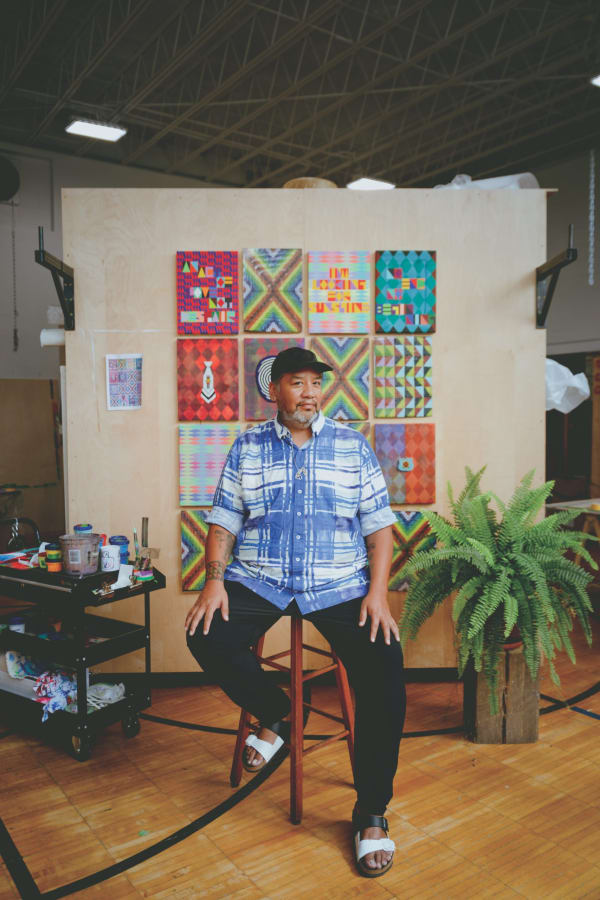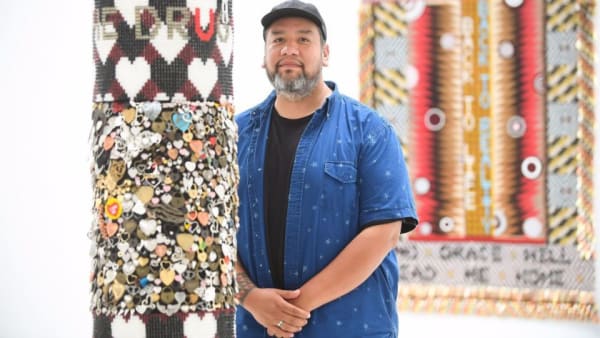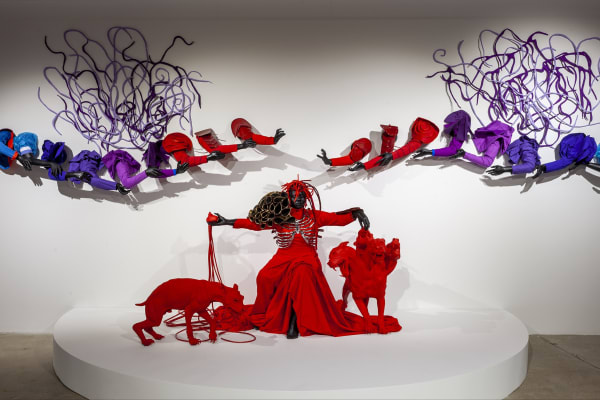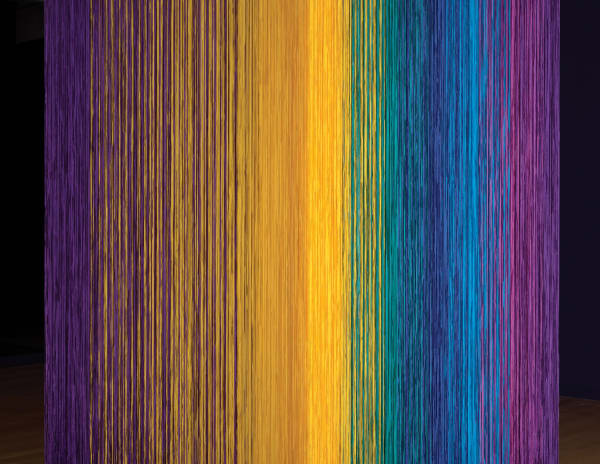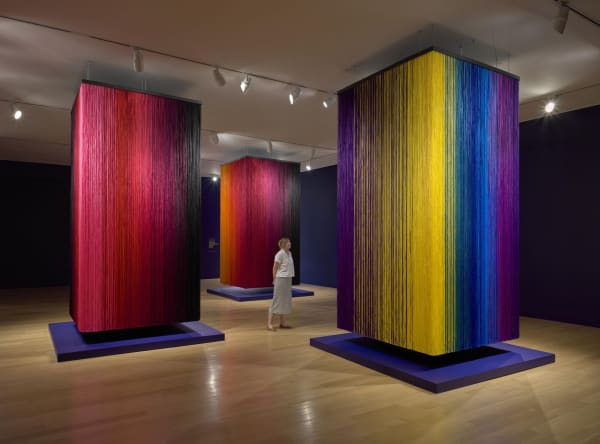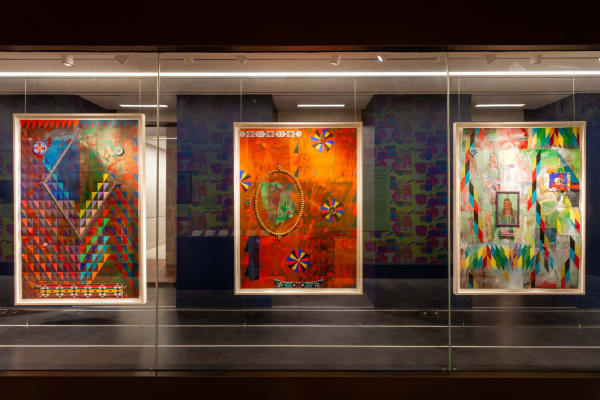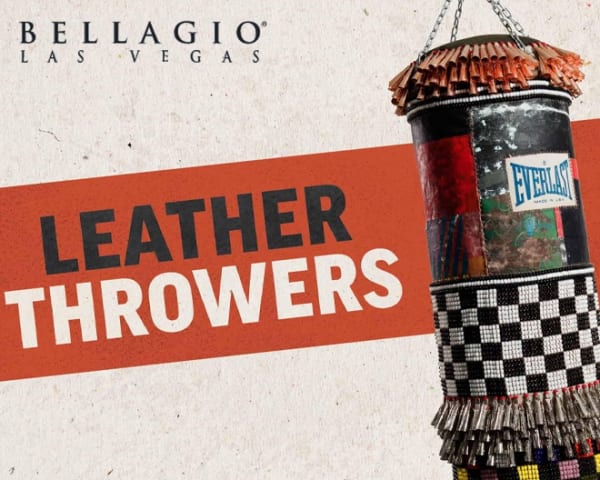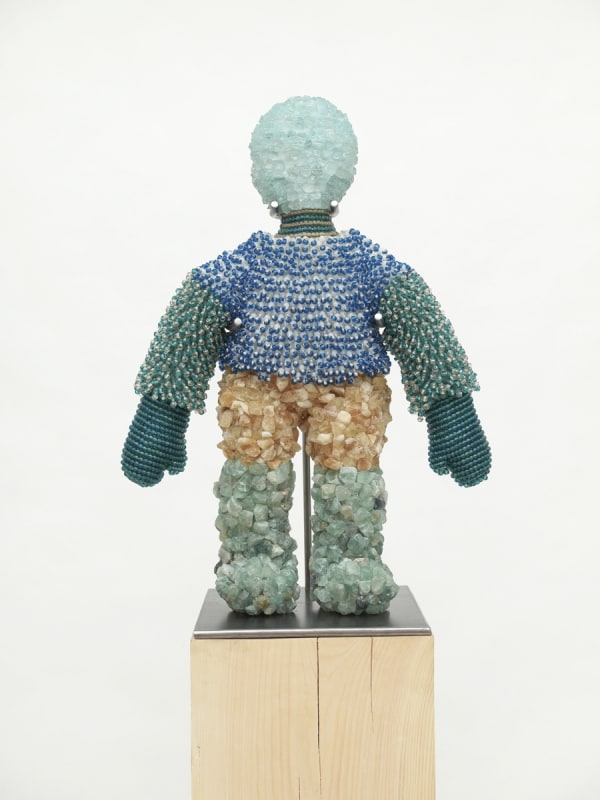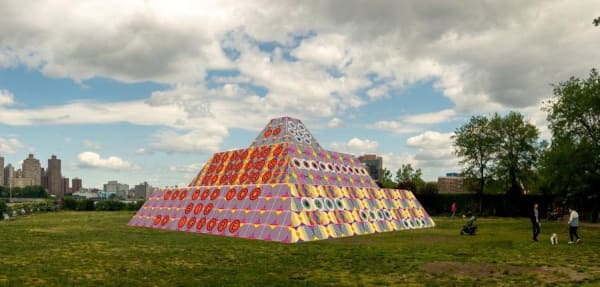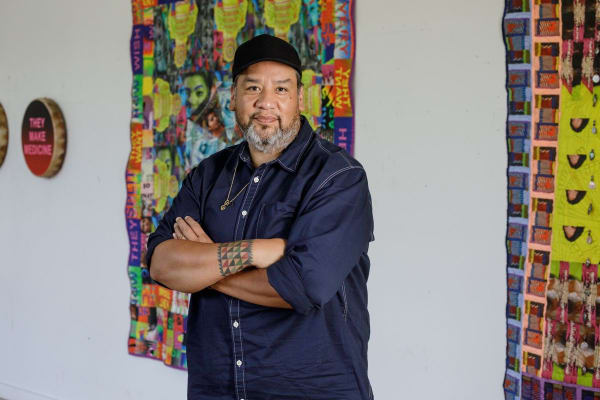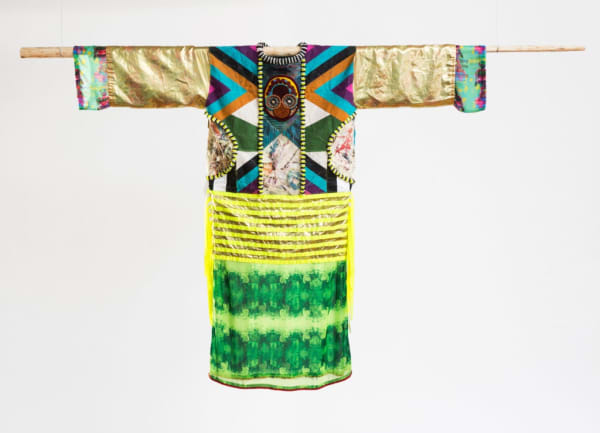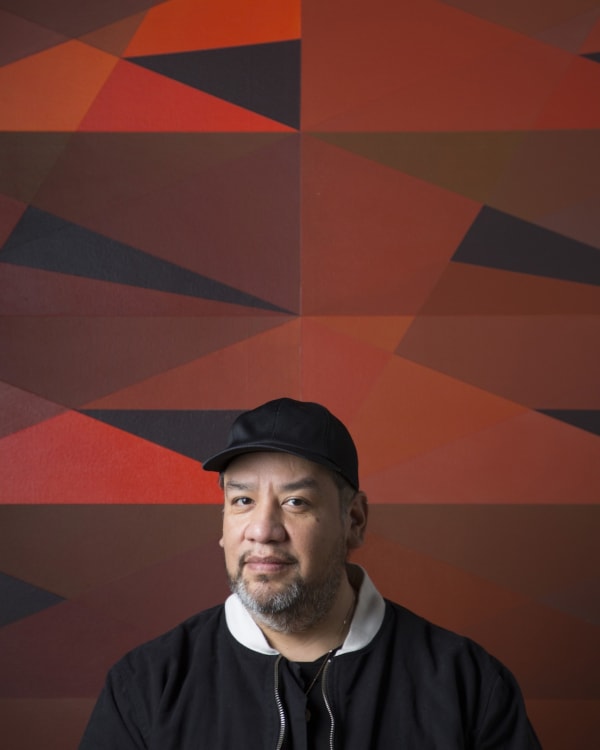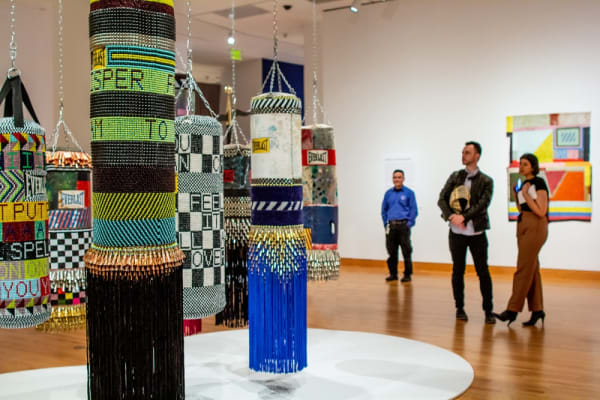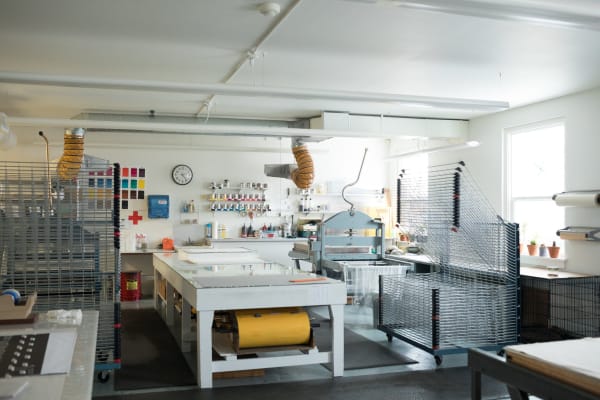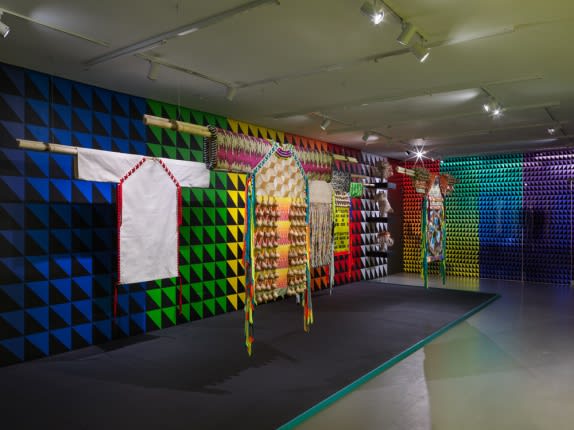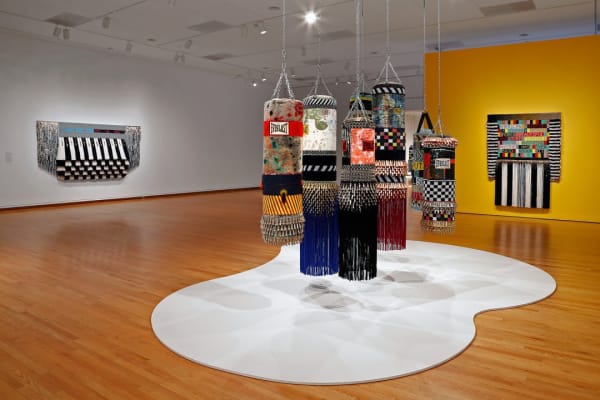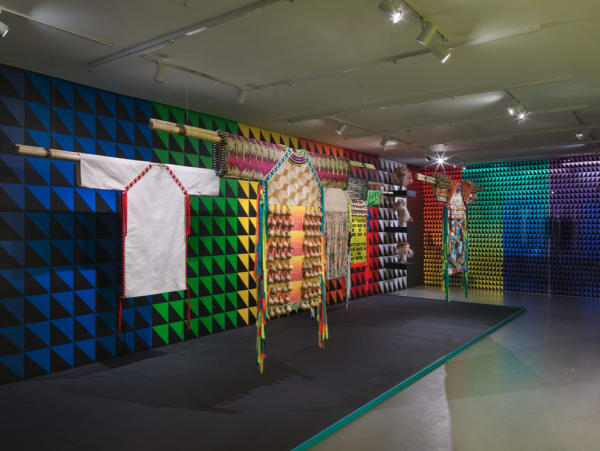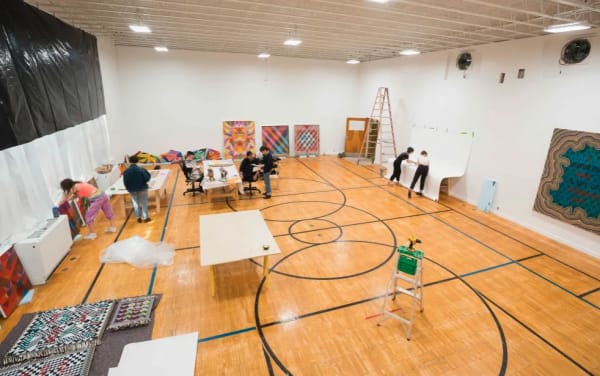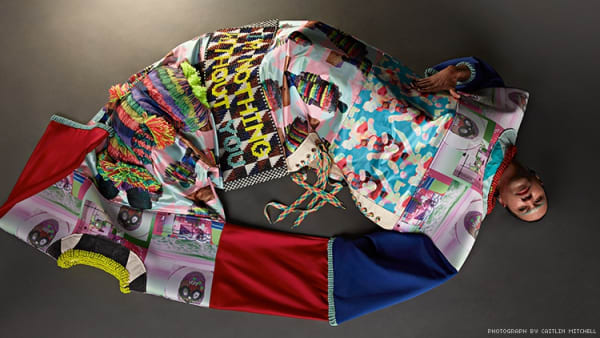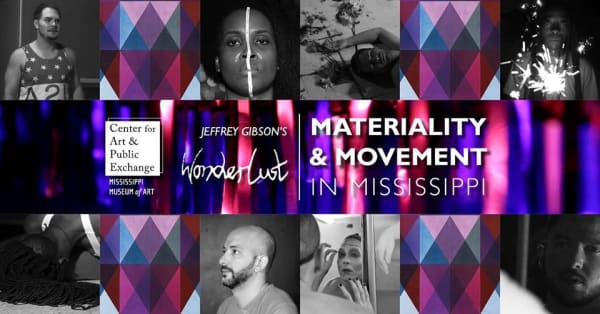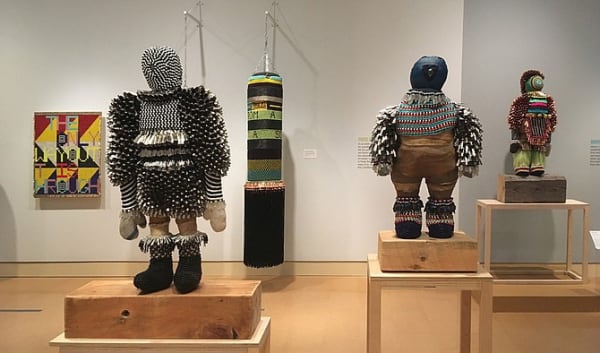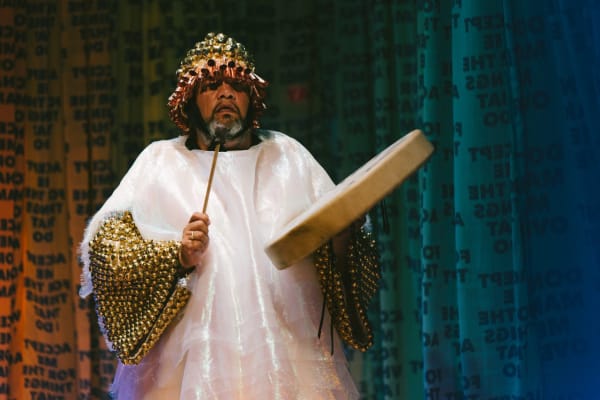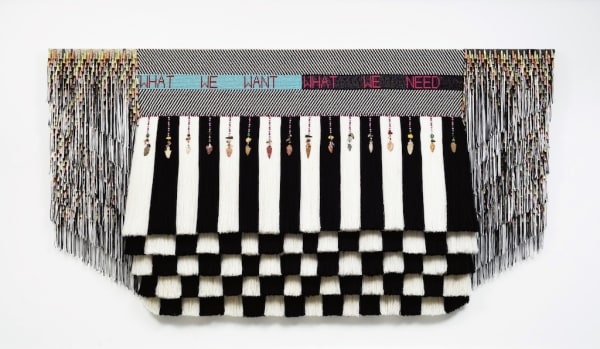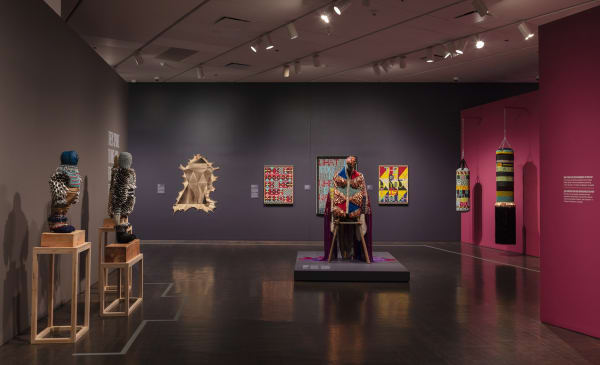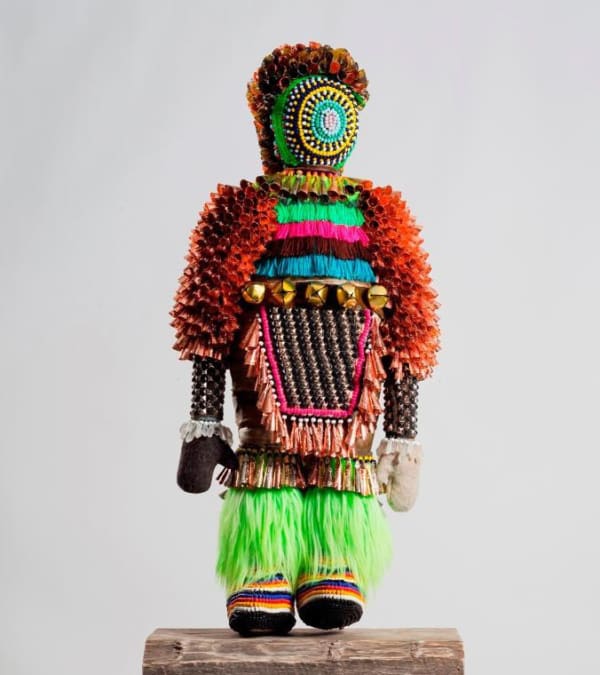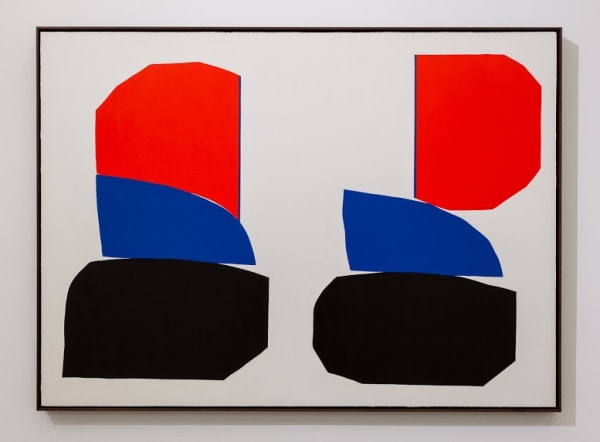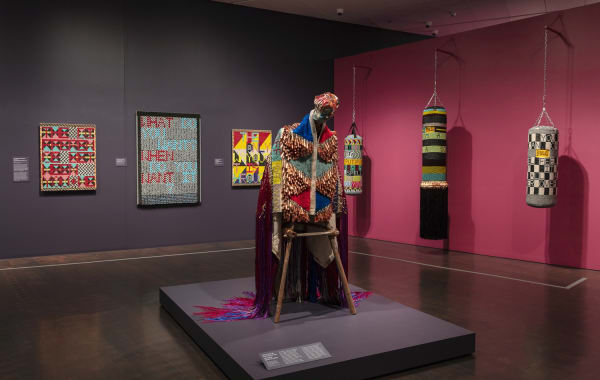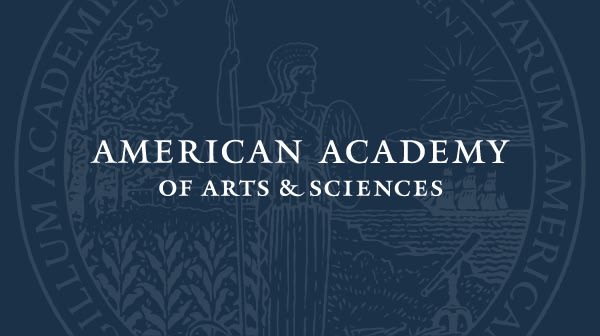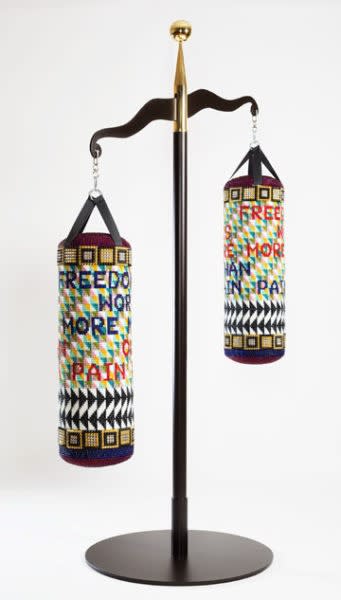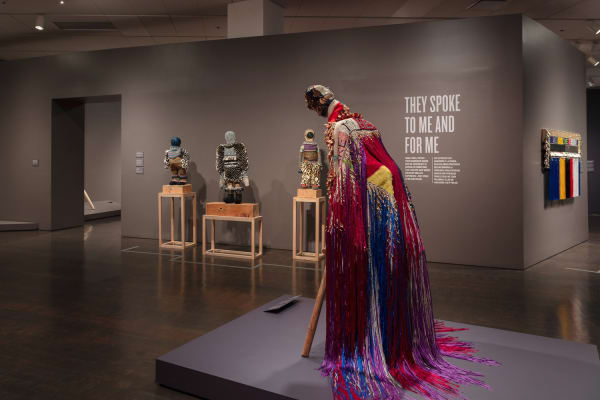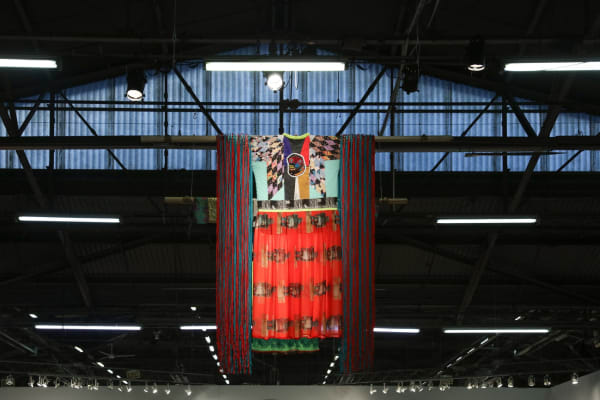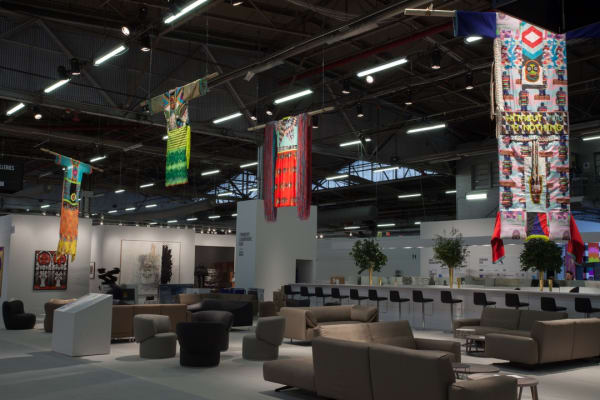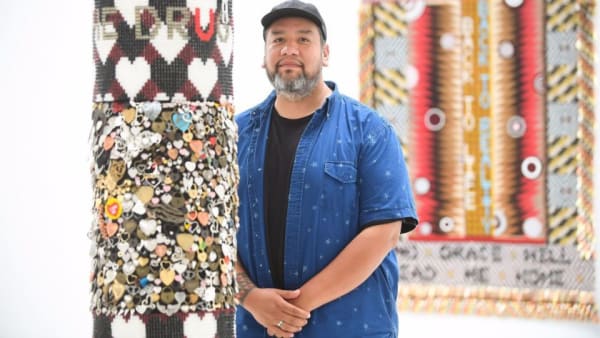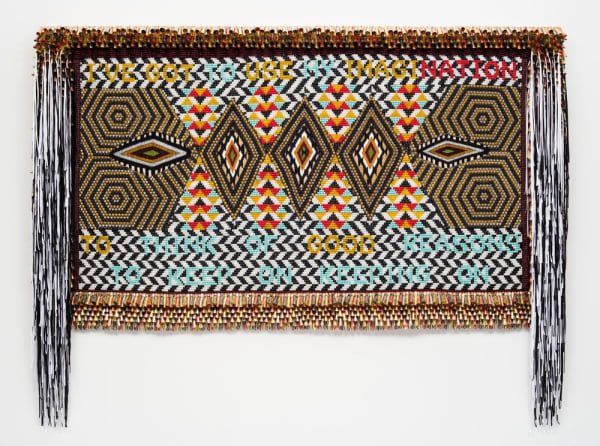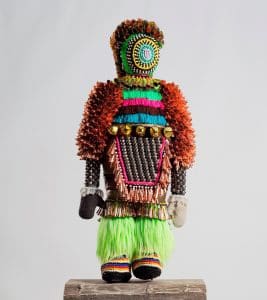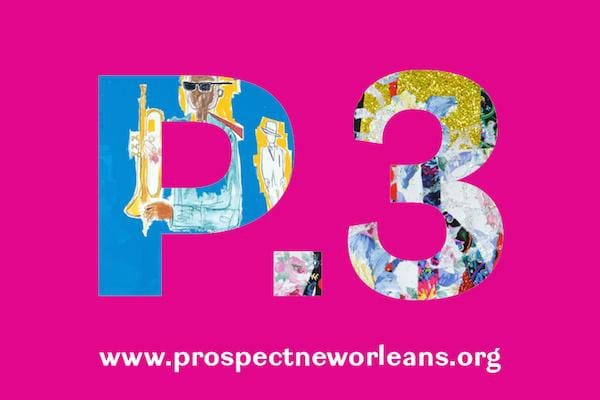Jeffrey Gibson USA, b. 1972
Jeffrey Gibson’s aesthetic position is rooted in the spaces where narratives collide. Gibson is a member of the Chocktaw and Cherokee nations. Combining Native American traditions with the visual languages of Modernism, his work re-contextualizes relationships between popular culture, identity politics, personal experience, memory, and canonized versions of history, inviting viewers to question the myths and assumptions that empower contemporary social structures.
As a child Gibson lived for long periods of time in Germany, Korea, and the United States. His multicultural perspective informed his study of art history and influenced the development of his aesthetic language. While moving around, Gibson found solace and friendship in the music scene, at various times exploring the sounds and social traditions of the punk, rave and PowWow communities. Song lyrics are a major aesthetic element in several of Gibson’s bodies of work, including his large-scale beaded paintings, his monumental installations and public works, as well as his beloved and highly influential series of beaded punching bags.
The power of musical performances is also integral to Gibson’s long running series of ceremonial garments. Alternately presenting as wearable fabrics and purely aesthetic relics, Gibson's garments elucidate the value of costumes as transformative objects that can help people take agency over their own identities. Exhibited in such environments as the entrance to the Whitney Biennial and the New York Armory Show, Gibson’s garments express a range of perspectives and influences, like symbols of history and culture that possess both personal and wider social meaning.
The intertwining and unraveling of cultural and material themes continues in Gibson’s recent series of Quilt Block Paintings. The pastiche appearance of these ambitious works is a material reflection of the intertextual narratives within. Says Gibson, “My grandmothers made quilts, and I collect quilts. I’m drawn to their patchwork quality. If you know where the fabrics are coming from, there’s a story that can be played out through material culture.”Images of Indigenous people appear throughout the Quilt Block Paintings, interrogating differences between how Native Americans represent themselves and how they are represented by others. Ranging from the cartoonish, to the melodramatic, to the profane, these images draw attention to inherent biases within intercultural visual narratives, such as the tendency of non-Indigenous artists to attribute dark skin tones to their perceived foes and light skin to individuals, such as Pocahontas, whom they wish to convey as friendly to colonial concerns.
All of Gibson's works deftly intermingle popular culture, literature, art history, memory, politics, myth, and material meaning. The source content he so insightfully remixes into new forms incites questions about whose representations of people and cultures should be validated; which memories and artifacts should be exalted; what creative products should be deemed to have constructive social value; and who decides. The works feel starkly original and idiosyncratic, but unified—a phenomenological manifestation of the complex, interwoven cultural fabrics that compete within our contemporary social space, and yet keep us stubbornly, inextricably bound.
Gibson is a MacArthur Foundation “Genius” Grantee; Joan Mitchell Foundation Painters & Sculptors Grantee; TED Foundation Fellow; Smithsonian Institution Contemporary Arts Grantee; HARPO Foundation Grantee; Eiteljorg Contemporary Art Fellow; Creative Capital Foundation Grantee; Mississippi Band of Choctaw Indians Tribal Scholarship awardee. His work is in the permanent collections of many of the most influential museums in the world, including the Whitney Museum of American Art, New York City, NY; Crystal Bridges Museum of American Art, Bentonville, AR; National Museum of the American Indian, Smithsonian Institution, Washington, D.C.; San Francisco Museum of Modern Art, San Francisco, CA; Seattle Art Museum, Seattle, WA; Speed Art Museum, Louisville, KY; Rose Museum of Art, Waltham, MA; San Antonio Museum of Art, San Antonia, TX; Denver Art Museum, Denver, CO; Eiteljorg Museum, Indianapolis, IN; Museum of Fine Arts, Boston, MA; National Gallery of Canada, Ottawa, Ontario, Canada; Nerman Museum of Contemporary Art, Overland Park, KS; Philbrook Museum of Art, Tulsa, OK; Nasher Museum of Art at Duke University, Durham, NC; Newark Museum of Art, Newark, NJ; Blanton Museum of Art, Austin, TX; Art Bridges Collection, Bentonville, AR; High Museum of Art, Atlanta, GA; Hood Museum, Dartmouth College, Hanover, NH; Minneapolis Museum of Art, Minneapolis, MN; Portland Museum of Art, Portland, ME; Tweed Museum of Art, Duluth, MN; and the Thoma Foundation, Santa Fe, NM and Chicago, IL.
Gibson holds an MA at the Royal College of Art, London, and a BFA from the School of the Art Institute of Chicago, and was awarded an Honorary Doctorate from Claremont Graduate University, Claremont, CA. Select major exhibitions of Gibson's work include Jeffrey Gibson: THE BODY ELECTRIC, Site Santa Fe, Santa Fe, NM, USA; Jeffrey Gibson: Beyond the Horizon, Kavi Gupta | Elizabeth St, Chicago, IL, USA; Jeffrey Gibson: When Fire is Applied to a Stone It Cracks, Brooklyn Art Museum, New York, NY, USA; Jeffrey Gibson: CAN YOU FEEL IT, Kavi Gupta, Chicago, IL, USA; She Never Dances Alone, Times Square Arts, New York, NY, USA; Jeffrey Gibson, Infinite Indigenous Queer Love, deCordova Sculpture Park and Museum, Lincoln, MA; Jeffrey Gibson: This Is the Day, Blanton Museum of Art, Austin, TX, USA; Wellin Museum of Art, Clinton, NY, USA; Jeffrey Gibson: The Anthropophagic Effect, The New Museum, New York, NY, USA; Jeffrey Gibson: Like a Hammer, Denver Art Museum, Denver, CO, USA; Garmenting: Costume as Contemporary Art, curated by Dr. Alexandra Schwartz, Ph.D., Museum of Arts and Design, New York, NY, USA; and Love Song, ICA, Boston, MA, USA.
-
 Jeffrey GibsonI'M LOOKING FOR SUNSHINE, 2021Canvas, Acrylic Paint, Vintage Beaded Necktie, Archival Pigment Print on Rice Paper, Glass Beads, Artificial Sinew, Wooden Beads, Vinyl Sequins, Nylon Thread66 1/2 x 50 1/2 x 3 1/4 in
Jeffrey GibsonI'M LOOKING FOR SUNSHINE, 2021Canvas, Acrylic Paint, Vintage Beaded Necktie, Archival Pigment Print on Rice Paper, Glass Beads, Artificial Sinew, Wooden Beads, Vinyl Sequins, Nylon Thread66 1/2 x 50 1/2 x 3 1/4 in
168.9 x 128.3 x 8.3 cm -
 Jeffrey GibsonLet Me Be Who You Need Me to Be, 2021Woven thread on a wooden loom ,
Jeffrey GibsonLet Me Be Who You Need Me to Be, 2021Woven thread on a wooden loom ,
The pieces are woven with 8/2 Tencel weft with a cotton warp. They remain mounted on their looms, which are custom built cherry wood looms handcrafted by woodworker Scottie Bellissemo. The finished pieces are 17”w x 21”h.21 x 17 x 2 in (Unframed)
53.3 x 43.2 x 5.1 cm -
 Jeffrey GibsonLet Me Be Who You Need Me to Be, 2021Woven thread on a wooden loom ,
Jeffrey GibsonLet Me Be Who You Need Me to Be, 2021Woven thread on a wooden loom ,
The pieces are woven with 8/2 Tencel weft with a cotton warp. They remain mounted on their looms, which are custom built cherry wood looms handcrafted by woodworker Scottie Bellissemo. The finished pieces are 17”w x 21”h.21 x 17 x 2 in (Unframed)
53.3 x 43.2 x 5.1 cm -
 Jeffrey GibsonPOWERFUL BECAUSE THEY’RE DIFFERENT , 2021Porcelain, Pottery Glaze, Steel Rod, Acrylic Chiffon, Glass Beads, Porcelain Base14 x 12 x 6 in
Jeffrey GibsonPOWERFUL BECAUSE THEY’RE DIFFERENT , 2021Porcelain, Pottery Glaze, Steel Rod, Acrylic Chiffon, Glass Beads, Porcelain Base14 x 12 x 6 in
35.6 x 30.5 x 15.2 cmSet of Unique works, total 30 made -
 Jeffrey GibsonSHE KNOWS OTHER WORLDS, 2021Digitally printed fabric, cotton batting, cotton thread and cotton fabric77 x 100 in
Jeffrey GibsonSHE KNOWS OTHER WORLDS, 2021Digitally printed fabric, cotton batting, cotton thread and cotton fabric77 x 100 in
195.6 x 254 cm -
 Jeffrey GibsonSHE KNOWS OTHER WORLDS, 2019Cotton and linen, digitally printed fabric, polyester thread, cotton batting90 x 103 1/2 in
Jeffrey GibsonSHE KNOWS OTHER WORLDS, 2019Cotton and linen, digitally printed fabric, polyester thread, cotton batting90 x 103 1/2 in
228.6 x 262.9 cm -
 Jeffrey GibsonSouvenir , 2018Quilt topper, canvas, acrylic paint, assorted glass and stone beads, nylon fringe and artificial sinew85 1/2 x 67 x 2 1/2 in
Jeffrey GibsonSouvenir , 2018Quilt topper, canvas, acrylic paint, assorted glass and stone beads, nylon fringe and artificial sinew85 1/2 x 67 x 2 1/2 in
217.2 x 170.2 x 6.3 cm -
 Jeffrey GibsonStand By Me, 2018Polyester organza, glass and plastic beads, printed chiffon, nylon ribbon, canvas, acrylic paint, repurposed artist’s paintings, PVC and artificial sinew78 1/4 x 98 x 2 1/2 in
Jeffrey GibsonStand By Me, 2018Polyester organza, glass and plastic beads, printed chiffon, nylon ribbon, canvas, acrylic paint, repurposed artist’s paintings, PVC and artificial sinew78 1/4 x 98 x 2 1/2 in
198.8 x 248.9 x 6.3 cm -
 Jeffrey GibsonTribes File Suit to Protect Bears Ears, 2018Polyester satin, printed chiffon, canvas, neoprene, tin jingles, nylon fringe, glass and plastic beads, and artificial sinew (on tipi poles)85 x 73 1/2 x 8 1/2 in
Jeffrey GibsonTribes File Suit to Protect Bears Ears, 2018Polyester satin, printed chiffon, canvas, neoprene, tin jingles, nylon fringe, glass and plastic beads, and artificial sinew (on tipi poles)85 x 73 1/2 x 8 1/2 in
215.9 x 186.7 x 21.6 cm -
 Jeffrey GibsonWindow, 2018Acrylic and graphite on canvas50 x 42 in
Jeffrey GibsonWindow, 2018Acrylic and graphite on canvas50 x 42 in
127 x 106.7 cm -
 Jeffrey GibsonALIVE!, 2016Glass beads, tin jingles, steel and brass studs, nylon fringe, and artificial sinew on acrylic felt, mounted on canvas100 x 61 1/4 in
Jeffrey GibsonALIVE!, 2016Glass beads, tin jingles, steel and brass studs, nylon fringe, and artificial sinew on acrylic felt, mounted on canvas100 x 61 1/4 in
254 x 155.6 cm -
 Jeffrey GibsonLOOK HOW FAR WE’VE COME!, 2016Screen print30 x 22 x 1 UnframedUnique Monoprint Series, AP of 12
Jeffrey GibsonLOOK HOW FAR WE’VE COME!, 2016Screen print30 x 22 x 1 UnframedUnique Monoprint Series, AP of 12 -
 Jeffrey GibsonLOOK HOW FAR WE’VE COME!, 2016Screen print22 x 30 x 1 UnframedUnique Monoprint Series, AP of 12
Jeffrey GibsonLOOK HOW FAR WE’VE COME!, 2016Screen print22 x 30 x 1 UnframedUnique Monoprint Series, AP of 12 -
 Jeffrey GibsonLOOK HOW FAR WE’VE COME!, 2016Screen print30 x 22 x 1 UnframedUnique Monoprint Series, #2 of 83
Jeffrey GibsonLOOK HOW FAR WE’VE COME!, 2016Screen print30 x 22 x 1 UnframedUnique Monoprint Series, #2 of 83 -
 Jeffrey GibsonLOOK HOW FAR WE’VE COME!, 2016Screen print30 x 22 in Unframed
Jeffrey GibsonLOOK HOW FAR WE’VE COME!, 2016Screen print30 x 22 in Unframed
35 x 27.5 x 1.5 in FramedUnique Monoprint Series, #30 of 83 -
 Jeffrey GibsonLOOK HOW FAR WE’VE COME!, 2016Screen print30 x 22 in Unframed
Jeffrey GibsonLOOK HOW FAR WE’VE COME!, 2016Screen print30 x 22 in Unframed
35 x 27.5 x 1.5 in FramedUnique Monoprint Series, #34 of 83 -
 Jeffrey GibsonLOOK HOW FAR WE’VE COME!, 2016Screen print22 x 30 x 1 UnframedUnique Monoprint Series, #42 of 83
Jeffrey GibsonLOOK HOW FAR WE’VE COME!, 2016Screen print22 x 30 x 1 UnframedUnique Monoprint Series, #42 of 83 -
 Jeffrey GibsonLOOK HOW FAR WE’VE COME!, 2016Screen print30 x 22 x 1 UnframedUnique Monoprint Series, #48 of 83
Jeffrey GibsonLOOK HOW FAR WE’VE COME!, 2016Screen print30 x 22 x 1 UnframedUnique Monoprint Series, #48 of 83 -
 Jeffrey GibsonLOOK HOW FAR WE’VE COME!, 2016Screen print30 x 22 x 1 UnframedUnique Monoprint Series, #52 of 83
Jeffrey GibsonLOOK HOW FAR WE’VE COME!, 2016Screen print30 x 22 x 1 UnframedUnique Monoprint Series, #52 of 83 -
 Jeffrey GibsonLOOK HOW FAR WE’VE COME!, 2016Screen print22 x 30 x 1 UnframedUnique Monoprint Series, #56 of 83
Jeffrey GibsonLOOK HOW FAR WE’VE COME!, 2016Screen print22 x 30 x 1 UnframedUnique Monoprint Series, #56 of 83 -
 Jeffrey GibsonLOOK HOW FAR WE’VE COME!, 2016Screen print30 x 22 x 1 UnframedUnique Monoprint Series, #60 of 83
Jeffrey GibsonLOOK HOW FAR WE’VE COME!, 2016Screen print30 x 22 x 1 UnframedUnique Monoprint Series, #60 of 83 -
 Jeffrey GibsonRadiant Tushka, 2018Repurposed quilt; assorted glass, plastic, and stone beads; printed chiffon; nylon ribbon; canvas; acrylic paint; nylon fringe; copper and artificial sinew95 1/2 x 64 x 2 1/2 in
Jeffrey GibsonRadiant Tushka, 2018Repurposed quilt; assorted glass, plastic, and stone beads; printed chiffon; nylon ribbon; canvas; acrylic paint; nylon fringe; copper and artificial sinew95 1/2 x 64 x 2 1/2 in
242.6 x 162.6 x 6.3 cm -
 Jeffrey GibsonPOWERFUL BECAUSE THEY’RE DIFFERENT , 2021Porcelain, Pottery Glaze, Steel Rod, Acrylic Chiffon, Glass Beads, Porcelain Base14 x 12 x 6 in
Jeffrey GibsonPOWERFUL BECAUSE THEY’RE DIFFERENT , 2021Porcelain, Pottery Glaze, Steel Rod, Acrylic Chiffon, Glass Beads, Porcelain Base14 x 12 x 6 in
35.6 x 30.5 x 15.2 cm -
 Jeffrey GibsonPOWERFUL BECAUSE THEY’RE DIFFERENT , 2021Porcelain, Pottery Glaze, Steel Rod, Acrylic Chiffon, Glass Beads, Porcelain Base14 x 12 x 6 in
Jeffrey GibsonPOWERFUL BECAUSE THEY’RE DIFFERENT , 2021Porcelain, Pottery Glaze, Steel Rod, Acrylic Chiffon, Glass Beads, Porcelain Base14 x 12 x 6 in
35.6 x 30.5 x 15.2 cm -
 Jeffrey GibsonPOWERFUL BECAUSE THEY’RE DIFFERENT , 2021(Unique Flag melded to the figure a "Native" sculpture from the Brooklyn Museum's collection & Gibsons solo exhibition at the Museum ) of hand-glazed Porcelain, Pottery Glaze, Steel Rod, Acrylic Chiffon, Glass Beads, Porcelain Base14 x 12 x 6 in
Jeffrey GibsonPOWERFUL BECAUSE THEY’RE DIFFERENT , 2021(Unique Flag melded to the figure a "Native" sculpture from the Brooklyn Museum's collection & Gibsons solo exhibition at the Museum ) of hand-glazed Porcelain, Pottery Glaze, Steel Rod, Acrylic Chiffon, Glass Beads, Porcelain Base14 x 12 x 6 in
35.6 x 30.5 x 15.2 cm -
 Jeffrey GibsonTHE SPIRITS ARE LAUGHING, 2021Printed vinyl flag60 x 96 in
Jeffrey GibsonTHE SPIRITS ARE LAUGHING, 2021Printed vinyl flag60 x 96 in
152.4 x 243.8 cmEdition of 3 plus 1 artist's proof -
 Jeffrey GibsonBETTER BECAUSE WE CAN BE, 2022Canvas, acrylic paint, glass beads, artificial sinew, and nylon thread66 1/2 x 50 1/2 x 3 1/4
Jeffrey GibsonBETTER BECAUSE WE CAN BE, 2022Canvas, acrylic paint, glass beads, artificial sinew, and nylon thread66 1/2 x 50 1/2 x 3 1/4
168.9 x 128.3 x 8.3 -
 Jeffrey GibsonBY ANY MEANS NECESSARY, 2021Canvas, acrylic paint, glass beads, artificial sinew, nylon thread, vintage beaded belt buckle (Suede, glass beads, cotton thread), vintage beaded whimsey (Cotton fabric, velvet, glass beads, cotton thread) vintage beaded bag (Suede, glass beads, cotton thread)66 1/2 x 50 1/2 x 3 1/4
Jeffrey GibsonBY ANY MEANS NECESSARY, 2021Canvas, acrylic paint, glass beads, artificial sinew, nylon thread, vintage beaded belt buckle (Suede, glass beads, cotton thread), vintage beaded whimsey (Cotton fabric, velvet, glass beads, cotton thread) vintage beaded bag (Suede, glass beads, cotton thread)66 1/2 x 50 1/2 x 3 1/4
168.9 x 128.3 x 8.3 -
 Jeffrey GibsonMAKE ME FEEL IT, 2021Canvas, Acrylic Paint, Vintage Beaded Barrette, Glass Beads, Artificial Sinew, Tumbled Stone Beads, Plastic Beads, Wooden Beads, Cross Pearl Pendants, Nylon Thread66 1/2 x 50 1/2 x 3 1/4 in
Jeffrey GibsonMAKE ME FEEL IT, 2021Canvas, Acrylic Paint, Vintage Beaded Barrette, Glass Beads, Artificial Sinew, Tumbled Stone Beads, Plastic Beads, Wooden Beads, Cross Pearl Pendants, Nylon Thread66 1/2 x 50 1/2 x 3 1/4 in
168.9 x 128.3 x 8.3 cm -
 Jeffrey GibsonOVER THE RAINBOW, 2021Canvas, Acrylic Paint, Vintage Beaded Necktie, Archival Pigment Print on Rice Paper, Glass Beads, Artificial Sinew, Wooden Beads, Vinyl Sequins, Brass Adornment, Druzy Bead, Nylon Thread66 1/2 x 50 1/2 x 3 1/4 in
Jeffrey GibsonOVER THE RAINBOW, 2021Canvas, Acrylic Paint, Vintage Beaded Necktie, Archival Pigment Print on Rice Paper, Glass Beads, Artificial Sinew, Wooden Beads, Vinyl Sequins, Brass Adornment, Druzy Bead, Nylon Thread66 1/2 x 50 1/2 x 3 1/4 in
168.9 x 128.3 x 8.3 cm -
 Jeffrey GibsonTHE FIRE NEXT TIME, 2021Canvas, acrylic paint, glass beads, artificial sinew, nylon thread, vintage beaded belt buckle (Suede, glass beads, cotton thread), vintage beaded wallet (glass beads, cotton fabric, cotton thread), vintage wooded tie slide66 1/2 x 50 1/2 x 3 1/4
Jeffrey GibsonTHE FIRE NEXT TIME, 2021Canvas, acrylic paint, glass beads, artificial sinew, nylon thread, vintage beaded belt buckle (Suede, glass beads, cotton thread), vintage beaded wallet (glass beads, cotton fabric, cotton thread), vintage wooded tie slide66 1/2 x 50 1/2 x 3 1/4
168.9 x 128.3 x 8.3 -
 Jeffrey GibsonTHEY PLAY ENDLESSLY, 2021Canvas, Acrylic Paint, Vintage Beaded Wallet, Vintage Wooden Broach, Archival Pigment Print on Rice Paper, Glass Beads, Artificial Sinew, Hematite Beads, Plastic Beads, Druzy Beads, Metal Sequins, Turquoise Beads, Nylon Thread66 1/2 x 50 1/2 x 3 1/4 in
Jeffrey GibsonTHEY PLAY ENDLESSLY, 2021Canvas, Acrylic Paint, Vintage Beaded Wallet, Vintage Wooden Broach, Archival Pigment Print on Rice Paper, Glass Beads, Artificial Sinew, Hematite Beads, Plastic Beads, Druzy Beads, Metal Sequins, Turquoise Beads, Nylon Thread66 1/2 x 50 1/2 x 3 1/4 in
168.9 x 128.3 x 8.3 cm -
 Jeffrey GibsonChief Black Coyote, 2021Mixed Media Collage, Acrylic Paint, Vintage Beaded Barrette (Glass Beads, Polyester, Suede Cotton Thread), Vintage Beaded Belt Buckle (Glass Beads, Suede, Polyester, Thread) Vintage Pin, Beaded Belt (Glass Beads, Cotton Thread) Glass Beads, Nylon Thread71 x 48 x 1 1/2 in
Jeffrey GibsonChief Black Coyote, 2021Mixed Media Collage, Acrylic Paint, Vintage Beaded Barrette (Glass Beads, Polyester, Suede Cotton Thread), Vintage Beaded Belt Buckle (Glass Beads, Suede, Polyester, Thread) Vintage Pin, Beaded Belt (Glass Beads, Cotton Thread) Glass Beads, Nylon Thread71 x 48 x 1 1/2 in
180.3 x 121.9 x 3.8 cm -
 Jeffrey GibsonWhite Swan, 2021Mixed Media Collage, Acrylic Paint, Vintage Beaded Barrette (Glass Beads, Suede, Cotton Thread), Vintage Beaded Appliqué (Glass Beads, Polyester, Thread) Glass Beads, Nylon Thread64 x 48 x 1 1/2 in
Jeffrey GibsonWhite Swan, 2021Mixed Media Collage, Acrylic Paint, Vintage Beaded Barrette (Glass Beads, Suede, Cotton Thread), Vintage Beaded Appliqué (Glass Beads, Polyester, Thread) Glass Beads, Nylon Thread64 x 48 x 1 1/2 in
162.6 x 121.9 x 3.8 cm -
 Jeffrey GibsonBoneta, 2021Mixed Media Collage, Acrylic Paint, Glass Beads, Nylon Thread, Vintage Beaded Belt (Glass Beads, Suede, Cotton Thread), Vintage Beaded Barrettes (Glass Beads, Suede, Polyester, Thread), Vintage Ring Toss Game From Japan (Print, Cardboard, Clear Plastic), Brass Repousse64 x 48 x 1 1/2 in
Jeffrey GibsonBoneta, 2021Mixed Media Collage, Acrylic Paint, Glass Beads, Nylon Thread, Vintage Beaded Belt (Glass Beads, Suede, Cotton Thread), Vintage Beaded Barrettes (Glass Beads, Suede, Polyester, Thread), Vintage Ring Toss Game From Japan (Print, Cardboard, Clear Plastic), Brass Repousse64 x 48 x 1 1/2 in
162.6 x 121.9 x 3.8 cm -
 Jeffrey GibsonChief Pretty Eagle, 2020Mixed Media Collage, Vintage Beaded Eyeglass Case (Glass Beads, Polyester, Thread, Suede), Vintage Beaded Barrette (Glass Beads, Polyester, Thread), Vintage Papers, Found Pin, Glass Beads, Glitter, Urethane, Acrylic Paint64 x 48 x 1 1/2 in
Jeffrey GibsonChief Pretty Eagle, 2020Mixed Media Collage, Vintage Beaded Eyeglass Case (Glass Beads, Polyester, Thread, Suede), Vintage Beaded Barrette (Glass Beads, Polyester, Thread), Vintage Papers, Found Pin, Glass Beads, Glitter, Urethane, Acrylic Paint64 x 48 x 1 1/2 in
162.6 x 121.9 x 3.8 cm -
 Jeffrey GibsonChristian Naiche, 2021Mixed Media Collage, Acrylic Paint, Vintage Beaded Picture Frame (Glass Beads, Cotton Fabric, Cardboard, Velvet, Cotton Thread, Suede), Vintage Pin, Vintage Beaded Barrette (Glass Beads, Suede, Polyester, Thread) Vintage Beaded Belt Buckle (Glass Beads, Suede, Polyester, Thread), Vintage Beaded Whimsey (Glass Beads, Velvet, Cardboard, Saw Dust, Thread) Glass Beads, Nylon Thread64 x 48 x 1 1/2 in
Jeffrey GibsonChristian Naiche, 2021Mixed Media Collage, Acrylic Paint, Vintage Beaded Picture Frame (Glass Beads, Cotton Fabric, Cardboard, Velvet, Cotton Thread, Suede), Vintage Pin, Vintage Beaded Barrette (Glass Beads, Suede, Polyester, Thread) Vintage Beaded Belt Buckle (Glass Beads, Suede, Polyester, Thread), Vintage Beaded Whimsey (Glass Beads, Velvet, Cardboard, Saw Dust, Thread) Glass Beads, Nylon Thread64 x 48 x 1 1/2 in
162.6 x 121.9 x 3.8 cm -
 Jeffrey GibsonPahl Lee, 2021Mixed Media Collage, Acrylic Paint, Vintage Beaded Handbag (Glass Beads, Cotton Fabric, Leather, Brass Enclosure, Polyester, Cotton Thread), Glass Beads64 x 48 x 1 1/2 in
Jeffrey GibsonPahl Lee, 2021Mixed Media Collage, Acrylic Paint, Vintage Beaded Handbag (Glass Beads, Cotton Fabric, Leather, Brass Enclosure, Polyester, Cotton Thread), Glass Beads64 x 48 x 1 1/2 in
162.6 x 121.9 x 3.8 cm -
 Jeffrey GibsonBlack Beauty, 2021Glass beads, acrylic felt, polyester fiber fill, artificial sinew, nylon thread, vintage beaded elements (glass beads, suede, cotton thread)16 x 23 x 13 1/4 in
Jeffrey GibsonBlack Beauty, 2021Glass beads, acrylic felt, polyester fiber fill, artificial sinew, nylon thread, vintage beaded elements (glass beads, suede, cotton thread)16 x 23 x 13 1/4 in
40.6 x 58.4 x 33.7 cm -
 Jeffrey GibsonFirebelly, 2021Glass beads, acrylic felt, polyester fiber fill, artificial sinew, nylon thread, vintage beaded elements (glass beads, suede, cotton thread)16 x 23 x 13 1/4 in
Jeffrey GibsonFirebelly, 2021Glass beads, acrylic felt, polyester fiber fill, artificial sinew, nylon thread, vintage beaded elements (glass beads, suede, cotton thread)16 x 23 x 13 1/4 in
40.6 x 58.4 x 33.7 cm -
 Jeffrey GibsonNO MORE WAR, 2020Acrylic on canvas, glass beads and artificial sinew inset into custom wood frame64 x 58 x 2 1/2 in
Jeffrey GibsonNO MORE WAR, 2020Acrylic on canvas, glass beads and artificial sinew inset into custom wood frame64 x 58 x 2 1/2 in
162.6 x 147.3 x 6.3 cm -
 Jeffrey GibsonLET ME BE WHO YOU NEED ME TO BE, 2020Acrylic on canvas, glass beads, and artificial sinew inset into custom wood frame78 x 46 x 2 1/2 in
Jeffrey GibsonLET ME BE WHO YOU NEED ME TO BE, 2020Acrylic on canvas, glass beads, and artificial sinew inset into custom wood frame78 x 46 x 2 1/2 in
198.1 x 116.8 x 6.3 cm -
 Jeffrey GibsonSHE KNOWS OTHER WORLDS, 2019Acrylic on canvas, glass beads and artificial sinew inset into custom wood frame82 x 74 in
Jeffrey GibsonSHE KNOWS OTHER WORLDS, 2019Acrylic on canvas, glass beads and artificial sinew inset into custom wood frame82 x 74 in
208.3 x 188 cm -
 Jeffrey GibsonBEFORE THE DEVIL KNOWS YOU'RE DEAD, 2019Acrylic on canvas, glass beads and artificial sinew inset into custom wood frame78 x 78 in
Jeffrey GibsonBEFORE THE DEVIL KNOWS YOU'RE DEAD, 2019Acrylic on canvas, glass beads and artificial sinew inset into custom wood frame78 x 78 in
198.1 x 198.1 cm -
 Jeffrey GibsonA CHANGE IS GONNA COME, 2019Acrylic on canvas, glass beads and artificial sinew inset into custom wood frame82 x 74 in
Jeffrey GibsonA CHANGE IS GONNA COME, 2019Acrylic on canvas, glass beads and artificial sinew inset into custom wood frame82 x 74 in
208.3 x 188 cm -
 Jeffrey GibsonALL I EVER WANTED ALL I EVER NEEDED, 2019Found canvas punching bag, glass beads, plastic beads, artificial sinew, steel studs, acrylic paint, steel chain85 x 20 x 20 in
Jeffrey GibsonALL I EVER WANTED ALL I EVER NEEDED, 2019Found canvas punching bag, glass beads, plastic beads, artificial sinew, steel studs, acrylic paint, steel chain85 x 20 x 20 in
215.9 x 50.8 x 50.8 cm -
 Jeffrey GibsonBE WITCHED BOTHERED AND BE WILDERED, 2019Found canvas punching bag, glass beads, plastic beads, artificial sinew, steel studs, acrylic paint, steel chain68 x 20 x 20 in
Jeffrey GibsonBE WITCHED BOTHERED AND BE WILDERED, 2019Found canvas punching bag, glass beads, plastic beads, artificial sinew, steel studs, acrylic paint, steel chain68 x 20 x 20 in
172.7 x 50.8 x 50.8 cm -
 Jeffrey GibsonALL THE THINGS THAT WE SHOULD HAVE SAID, 2019Acrylic on canvas, glass beads and artificial sinew inset
Jeffrey GibsonALL THE THINGS THAT WE SHOULD HAVE SAID, 2019Acrylic on canvas, glass beads and artificial sinew inset
into custom wood frame82 x 74 in
208.3 x 188 cm -
 Jeffrey GibsonI'M GONNA RUN WITH EVERY MINUTE I CAN BORROW, 2019Acrylic on canvas, glass beads and artificial sinew inset into wood frame
Jeffrey GibsonI'M GONNA RUN WITH EVERY MINUTE I CAN BORROW, 2019Acrylic on canvas, glass beads and artificial sinew inset into wood frame
82 x 74 x 2 1/2 in
208.3 x 188 x 6.3 cm -
 Jeffrey GibsonIF THIS WORLD WERE MINE, 2019Acrylic on canvas, glass beads and artificial sinew inset into custom wood frame50 x 42 x 3 in
Jeffrey GibsonIF THIS WORLD WERE MINE, 2019Acrylic on canvas, glass beads and artificial sinew inset into custom wood frame50 x 42 x 3 in
127 x 106.7 x 7.6 cm -
 Jeffrey GibsonI’VE NEVER MET ANYONE QUITE LIKE YOU BEFORE, 2019Acrylic on canvas, glass beads and artificial sinew inset into custom wood frame82 x 74 in
Jeffrey GibsonI’VE NEVER MET ANYONE QUITE LIKE YOU BEFORE, 2019Acrylic on canvas, glass beads and artificial sinew inset into custom wood frame82 x 74 in
208.3 x 188 cm -
 Jeffrey GibsonMAKING THE BEST OF A BAD SITUATION, 2017Glass beads, artificial sinew, tin jingles, metal studs, acrylic felt, canvas, over wood panel45 x 39 x 4.5 in
Jeffrey GibsonMAKING THE BEST OF A BAD SITUATION, 2017Glass beads, artificial sinew, tin jingles, metal studs, acrylic felt, canvas, over wood panel45 x 39 x 4.5 in -
 Jeffrey GibsonMountain, 2018Acrylic and graphite on canvas50 x 42 in
Jeffrey GibsonMountain, 2018Acrylic and graphite on canvas50 x 42 in
127 x 106.7 cm -
 Jeffrey GibsonThe Beat Goes On, 2019Acrylic and graphite on rawhide covered hand drums, custom frame25 3/4 x 47 1/4 x 4 1/2 in
Jeffrey GibsonThe Beat Goes On, 2019Acrylic and graphite on rawhide covered hand drums, custom frame25 3/4 x 47 1/4 x 4 1/2 in
65.4 x 120 x 11.4 cm -
 Jeffrey GibsonTRAPPED IN THE DREAM OF THE OTHER (GD), 2019Found canvas punching bag, glass beads, plastic beads, artificial sinew, steel studs, acrylic paint, steel chain67 x 14 x 14 in
Jeffrey GibsonTRAPPED IN THE DREAM OF THE OTHER (GD), 2019Found canvas punching bag, glass beads, plastic beads, artificial sinew, steel studs, acrylic paint, steel chain67 x 14 x 14 in
170.2 x 35.6 x 35.6 cm -
 Jeffrey GibsonA Wag A Wit A Witness, 2018Polyester organza, repurposed Seminole patchwork, printed cotton, printed chiffon, repurposed Japanese sash, nylon fringe, canvas, acrylic paint, plastic beads, plastic trim and artificial sinew120 x 70 x 2 1/2 in
Jeffrey GibsonA Wag A Wit A Witness, 2018Polyester organza, repurposed Seminole patchwork, printed cotton, printed chiffon, repurposed Japanese sash, nylon fringe, canvas, acrylic paint, plastic beads, plastic trim and artificial sinew120 x 70 x 2 1/2 in
304.8 x 177.8 x 6.3 cm -
 Jeffrey GibsonPROTECTS THE LAND, 2019Cotton and linen, digitally printed fabric, polyester thread,
Jeffrey GibsonPROTECTS THE LAND, 2019Cotton and linen, digitally printed fabric, polyester thread,
cotton batting73 1/2 x 102 in
186.7 x 259.1 cm -
 Jeffrey GibsonSTAND YOUR GROUND, 2019Cotton and linen, digitally printed fabric, polyester thread, cotton batting87 1/2 x 68 in
Jeffrey GibsonSTAND YOUR GROUND, 2019Cotton and linen, digitally printed fabric, polyester thread, cotton batting87 1/2 x 68 in
222.3 x 172.7 cm -
 Jeffrey GibsonUNDERSTAND, 2019Cotton and linen, digitally printed fabric, polyester thread, cotton batting79 1/2 x 73 1/2 in
Jeffrey GibsonUNDERSTAND, 2019Cotton and linen, digitally printed fabric, polyester thread, cotton batting79 1/2 x 73 1/2 in
201.9 x 186.7 cm -
 Jeffrey GibsonPlease Don’t Go, 2015High fire ceramic, wool, deer hide, glass beads, drift wood, artificial sinew, copper and tin jingles,
Jeffrey GibsonPlease Don’t Go, 2015High fire ceramic, wool, deer hide, glass beads, drift wood, artificial sinew, copper and tin jingles,
arrowheads, smoky quartz, steel base42 x 13 x 18 in
106.7 x 33 x 45.7 cm -
 Jeffrey GibsonTHE LOVE YOU KEEP, 2017Glass beads, assorted beads, assorted metal tacks (bronze, zinc, nickel, and brass), artificial sinew, acrylic felt over skinning board66 x 15 3/4 in
Jeffrey GibsonTHE LOVE YOU KEEP, 2017Glass beads, assorted beads, assorted metal tacks (bronze, zinc, nickel, and brass), artificial sinew, acrylic felt over skinning board66 x 15 3/4 in
167.6 x 40 cm -
 Jeffrey GibsonTO SAY I LOVE YOU RIGHT OUT LOUD, 2019Acrylic on canvas, glass beads and artificial sinew inset into custom wood frame82 x 74 in
Jeffrey GibsonTO SAY I LOVE YOU RIGHT OUT LOUD, 2019Acrylic on canvas, glass beads and artificial sinew inset into custom wood frame82 x 74 in
208.3 x 188 cm -
 Jeffrey GibsonTROUBLE DON'T LAST ALWAYS, 2019Acrylic on canvas, glass beads, artificial sinew, custom wood frames80 x 57 x 3 in
Jeffrey GibsonTROUBLE DON'T LAST ALWAYS, 2019Acrylic on canvas, glass beads, artificial sinew, custom wood frames80 x 57 x 3 in
203.2 x 144.8 x 7.6 cm -
 Jeffrey GibsonWHEN FIRE IS APPLIED TO A STONE IT CRACKS, 2019Acrylic on canvas, glass beads and artificial sinew inset into custom wood frame78 x 78 in
Jeffrey GibsonWHEN FIRE IS APPLIED TO A STONE IT CRACKS, 2019Acrylic on canvas, glass beads and artificial sinew inset into custom wood frame78 x 78 in
198.1 x 198.1 cm -
 Jeffrey GibsonYOU BETTER LET SOME BODY LOVE YOU, 2019Acrylic on canvas, glass beads, artificial sinew, custom wood frames80 x 57 in
Jeffrey GibsonYOU BETTER LET SOME BODY LOVE YOU, 2019Acrylic on canvas, glass beads, artificial sinew, custom wood frames80 x 57 in
203.2 x 144.8 cm -
 Jeffrey GibsonYOU HAVE SET MY SOUL ON FIRE, 2019Acrylic on canvas, glass beads and artificial sinew inset
Jeffrey GibsonYOU HAVE SET MY SOUL ON FIRE, 2019Acrylic on canvas, glass beads and artificial sinew inset
into custom wood frame82 x 74 in
208.3 x 188 cm
-

Matter of Fact: Material as a Political Act
KAVI GUPTA | WASHINGTON BLVD. FL. 2 25 Apr - 10 Oct 2025These artists explore the politics of materiality, how thread, clay, pigment, and gesture can serve as acts of reclamation, resistance, and cultural continuity.Read more -

Jeffrey Gibson: The Body Electric
Frist Art Museum 3 Feb - 23 Apr 2023This major exhibition is devoted to one of today’s leading artists, whose multidisciplinary practice combines aspects of traditional Indigenous art and culture with a modernist visual vocabulary. Born in Colorado...Read more -

Jeffrey Gibson: THE SPIRITS ARE LAUGHING
Aspen Art Museum, Aspen, CO 4 Nov 2022 - 5 Nov 2023Jeffrey Gibson’s practice mixes Indigenous aesthetic histories with the visual language of Modernism to explore culture, history, and identity. The artist works with garments, sculpture, performance, video, and painting to...Read more -

Jeffrey Gibson, They Come From Fire
Portland Art Museum, Portland, OR 15 Oct 2022 - 26 Feb 2023An immersive, site-responsive installation by multimedia artist Jeffrey Gibson, They Come From Fire will transform the exterior windows on the facade of the museum’s main building as well as its...Read more -

Jeffrey Gibson, THIS BURNING WORLD
Institute of Contemporary Art San Francisco, San Francisco, CA 1 Oct 2022 - 26 Mar 2023THIS BURNING WORLD speaks to the urgency and importance of our collective relationship to the planet. It places the earth under the ICA SF building in dialogue with video of...Read more -

Jeffrey Gibson & Firelei Báez in Dialogues Across Disciplines
Ruth and Elmer Wellin Museum of Art | Hamilton College, Clinton, NY 17 Sep 2022 - 20 May 2023Dialogues Across Disciplines celebrates the ten year anniversary of the Ruth and Elmer Wellin Museum of Art. Featuring a selection of artworks acquired through gifts and purchases over the last...Read more -

Jeffrey Gibson in The Future of Work: Parallel Economies
Art Gallery Burlington, Burlington, Ontario, CA 27 Aug - 31 Dec 2022The Future of Work is a three-part exhibition series formed as sites of continual research on the labour markets, essential work, equity, and mobility. In collaboration with the Workers Arts...Read more -

Jeffrey Gibson, Pamela Council & Muna Malik in Another Justice: US is Them
Parrish Art Museum, Water Mill, NY 23 Jul - 6 Nov 2022The Parrish Art Museum has invited Hank Willis Thomas (b. 1976, Plainfield, NJ), a conceptual artist working with themes related to identity, commodity, media, and popular culture, and For Freedoms–the...Read more -

Jeffrey Gibson in Shinnecock Monuments | Another Justice: Us is Them
Parrish Art Museum, Water Mill, NY 4 Jul - 30 Sep 2022As part of the exhibition, Another Justice: US is Them—Hank Willis Thomas | For Freedoms , on view at the Parrish Art Museum from July 23 to November 6, the...Read more -

Jeffrey Gibson in This is Not America's Flag
The Broad, Los Angeles, CA 21 May - 25 Sep 2022Featuring over twenty artists, the special exhibition This Is Not America’s Flag spotlights the myriad ways artists explore the symbol of the flag of the United States of America, underscoring...Read more -

Jeffrey Gibson in Land Back
Galerie d’art Stewart Hall, Centre culturel de Pointe-Claire 7 May - 26 Jun 2022'As a cornerstone of this exhibition, Jeffrey Gibson presents his video I Was Here (2018), a return to the land as imagined as literal – a deep rootedness in the...Read more -

Jeffrey Gibson, The Body Electric
SITE Santa Fe, Santa Fe, NM 6 May - 11 Sep 2022Jeffrey Gibson's new solo exhibition, The Body Electric, features a comprehensive survey of Gibson’s multi-decade practice highlighting his purposeful use of material, provocative language, and collaborative community-rooted performances. The Body...Read more -

Jeffrey Gibson in Invisible Thread
Artis–Naples: The Baker Museum, Naples, FL 26 Mar - 24 Jul 2022Humans’ pursuit to transcend mortality and the physical world in order to bend their existence between time and space is an age-old journey. For as long as there have been...Read more -

Jeffrey Gibson: What is Left Unspoken, Love
High Museum of Art 25 Mar - 14 Aug 2022Is love intrinsic, or is it a habit? What is the difference between love and friendship? What is the relationship of love to truth, freedom, and justice? These are just...Read more -

Garmenting: Costume as Contemporary Art | Mary Sibande, Devan Shimoyama, Jeffrey Gibson, and Esmaa Mohamoud
Museum of Arts and Design, New York, NY 12 Mar - 14 Aug 2022The first global survey exhibition dedicated to the use of clothing as a medium of visual art, Garmenting: Costume as Contemporary Art examines work by thirty-five international contemporary artists, from...Read more -

Jeffrey Gibson, I AM YOUR RELATIVE
Museum of Contemporary Art, Toronto 10 Mar - 31 Jul 2022I AM YOUR RELATIVE is a multi-purpose installation featuring 15 moveable stages that will populate the Museum’s Floor 1. Co-commissioned by MOCA and the Toronto Biennial of Art (TBA), the...Read more -

Jeffrey Gibson: Pressing Innovation: Printing Fine Art in the Upper Midwest
The Chazen Museum of Art. Madison, WI 14 Feb - 15 May 2022Pressing Innovation explores the history and work of fine-art printing presses in the Upper Midwest, focusing on each press’s distinct mission and contribution to printmaking in the late 20th and...Read more -

SÉANCE an Evening of Performances Hosted by Jeffrey Gibson and Ále Campos in Celebration of Beyond the Horizon
Kavi Gupta | 219 N Elizabeth St. 17 - 18 Dec 2021Kavi Gupta presents SÉANCE, an evening of music, art, performance and community in celebration of Jeffrey Gibson’s stunning solo exhibition Beyond the Horizon , hosted by Gibson and multi-disciplinary artist...Read more -

Jeffrey Gibson, Beyond the Horizon
Kavi Gupta | 219 N. Elizabeth St. Floor 1, Chicago, IL, 60607 13 Nov 2021 - 8 Jan 2022Kavi Gupta presents Beyond the Horizon , a solo show of new works by Jeffrey Gibson, acclaimed visual artist and 2019 MacArthur Fellow. Gibson’s aesthetic position is rooted in the...Read more -

Jeffrey Gibson, INFINITE INDIGENOUS QUEER LOVE
deCordova Sculpture Park and Museum 17 Oct 2021 - 13 Mar 2022This exhibition concerns the intersections of four powerful words—INFINITE INDIGENOUS QUEER LOVE. The two outer terms suggest boundless spaces and generative, tender relationships. The two interior terms convey markers of identity that Jeffrey Gibson disassembles and reconstructs through his artistic practice as a queer Choctaw-Cherokee man. Altogether this title offers a bold, declarative framework for this exhibition which debuts a series of collages, an immersive display featuring three hanging fringe sculptures, and recent videos created with collaborators, musicians, and performers. Shown together, these dazzling artistic expressions suggest that identity is pieced together by public life, popular culture, and intimate human bonds.Read more -

Jeffrey Gibson, To Feel Myself Beloved on the Earth
Art OMI | Ghent, NY 11 Sep 2021 - 3 Jan 2022Jeffery Gibson's quilts, garments, drums, prints, and videos, are set to be featured in the Newmark Gallery's exhibition, To Feel Myself Beloved on the Earth . The exhibition title derives...Read more -

Jeffrey Gibson in re: collections, Six Decades at the Rose Art Museum
Rose Art Museum, Waltham, MA 25 Jun 2021 - 16 Jun 2024“I don’t want to wallow in art history,” wrote Jack Whitten. “I want to use art history as a catapult.' As an artist, Whitten recognized the past as both foundation...Read more -

Portals, at the NEON Foundation Featuring Jeffrey Gibson
Hellenic Parliament Library and Printing House | NEON, Greece 11 Jun - 31 Dec 2021Portals features 59 artists from 27 countries as part of the Cultural Programme of Contemporary Art 2021, a collaboration between the Hellenic Parliament and NEON. It is curated by Elina...Read more -

Jeffrey Gibson, BECAUSE ONCE YOU ENTER MY HOUSE, IT BECOMES OUR HOUSE
deCordova Sculpture Park and Museum | Lincoln, MA 4 Jun 2021 - 1 Jun 2022A monumental sculpture by renowned artist Jeffrey Gibson (Mississippi Choctaw-Cherokee), the title, Because Once You Enter My House, It Becomes Our House, comes from a song Gibson associates with nightclubs...Read more -

Jeffrey Gibson, Sweet Bitter Love: An Initiative of Toward Common Cause
The Newberry, Hanson Gallery | Chicago, IL 28 May - 18 Sep 2021Sweet Bitter Love: An Initiative of Toward Common Cause presents Jeffrey Gibson’s reflections on representations of Indigenous people in cultural institutions. Responding to a series of 19th-century portraits by Eldridge Ayer Burbank, Gibson (a member of the Mississippi Band of Choctaw Indians and of Cherokee descent) refutes the stereotypical imagery that, for centuries, has helped create and reinforce pernicious myths about Indigenous people.Read more -

Jeffrey Gibson, BECAUSE ONCE YOU ENTER MY HOUSE, IT BECOMES OUR HOUSE
Socrates Sculpture Park | Queens, NY 10 Jul 2020 - 23 Mar 2021For MONUMENTS NOW, Jeffrey Gibson—a recipient of a 2019 MacArthur Foundation “Genius Grant”—presents a monument to inclusion and diversity: Because Once You Enter My House, It Becomes Our House. Drawing from Indigenous Mississippian culture, architecture, activist graphic traditions, and queer performative strategies, the large-scale public sculpture projects a future vision of the world that embraces complexities within collective identity.Read more -

Jeffrey Gibson, She Never Dances Alone
Midnight Moment | Times Square, New York, NY 1 - 31 Mar 2020A multi-channel video created specifically for the screens of Times Square, She Never Dances Alone (2019) is Gibson’s celebration of the Indigenous matriarchy, centering on the jingle dress dance, a...Read more -

Duro Olowu: Seeing Chicago
Museum of Contemporary Art | Chicago, IL 29 Feb - 27 Sep 2020Drawing from the city’s public and private art collections, Duro Olowu curates a show that reimagines relationships between artists and objects across time, media, and geography. Featured artists include Jeffrey Gibson, Jae Jarrell, Wadsworth Jarrell, and Gerald Williams.Read more -

Jeffrey Gibson, WHEN FIRE IS APPLIED TO A STONE IT CRACKS
Brooklyn Museum | New York, NY 14 Feb 2020 - 10 Jan 2021In Jeffrey Gibson: When Fire Is Applied to a Stone It Cracks, the artist selected objects from the Brooklyn Museum collection, which are presented alongside his recent work. The resulting multimedia, floor-to-ceiling installation questions long-held institutional categorizations and representations of Indigenous peoples and Native American art.Read more -

Jeffrey Gibson, TIme Carriers
Esker Foundation | Calgary, Alberta, Canada 28 Sep - 20 Dec 2019Time Carriers conjures a vision of many hands providing a framework of support, a fluid utopia where trust and movement go hand in hand. It evokes a time frame that both unites and collapses present, past, and future into an undulating and responsive single unit, something that could best be described as community or family. This idea is especially appropriate when considering Jeffrey Gibson’s work, as he has always pushed to create kinship among unlikely partners.Read more -

Jeffrey Gibson, CAN YOU FEEL IT
Kavi Gupta | 219 N. Elizabeth St., Chicago, IL 20 Sep - 12 Dec 2019Kavi Gupta is thrilled to present CAN YOU FEEL IT, a solo show of new work by 2019 MacArthur Genius Grant award winner Jeffrey Gibson.Read more -

Jeffrey Gibson, THIS IS THE DAY
Blanton Museum of Art | Austin, TX 14 Jul - 29 Sep 2019Jeffrey Gibson: This Is the Day is a vibrant, celebratory exhibition in which the artist brings together his Choctaw and Cherokee heritage and a range of diverse artistic and cultural...Read more -

Jeffrey Gibson, Like a Hammer
Madison Museum of Contemporary Art | Madison, WI 3 Jun - 15 Sep 2019MMoCA is pleased to announce the 2019 presentation of artist Jeffrey Gibson’s first major museum exhibition. Organized by the Denver Art Museum (DAM) , Jeffrey Gibson: Like a Hammer will...Read more -

Jeffrey Gibson, To Name An Other IDENTIFY Performance
National Portrait Gallery | Smithsonian, Washington D.C. 22 May 2019The Smithsonian’s National Portrait Gallery presents a new work by multimedia artist Jeffrey Gibson for the latest iteration of “IDENTIFY,” the performance-art program created by the museum to recognize individuals who are missing from its historical collections.Read more -

Jeffrey Gibson, 2019 Whitney Biennial
Whitney Museum of American Art | NYC 17 May - 22 Sep 2019Kavi Gupta congratulates Jeffrey Gibson on the opening of the seventy-ninth Whitney Biennial hosted by The Whitney Museum of American Art.Read more -

Jeffrey Gibson, Like A Hammer
The Seattle Art Museum | Seattle, WA 28 Feb - 12 May 2019Jeffrey Gibson: Like a Hammer is a major museum exhibition presenting a significant selection of this contemporary artist’s exuberant artwork created since 2011.Read more -

Jeffrey Gibson, The Anthropophagic Effect
New Museum | NYC 13 Feb - 9 Jun 2019This exhibition is curated by Johanna Burton, Keith Haring Director and Curator of Education and Public Engagement, and Sara O’Keeffe, Associate Curator, with Kate Wiener, Curatorial Assistant.Read more -

Jeffrey Gibson, This is the Day
Wellin Museum of Art | Clinton, NY 8 Sep - 9 Dec 2018Jeffrey Gibson’s multidisciplinary practice encompasses a wide range of mediums and draws on a variety of influences and visual languages to comment on race, sexuality, religion, and gender, among other topical issues. Combining popular and queer culture with references to Native American history and current events, Gibson reflects on his Choctaw and Cherokee heritage as a means of exploring the significance, traditions, and rituals of personal adornment and identity.Read more -

Parallel Lives
Kavi Gupta | 835 W. Washington St. Chicago, IL, 60607 16 Jun - 24 Aug 2018Kavi Gupta is pleased to present Parallel Lives. This group exhibition brings a diverse selection of contemporary artists working in figuration and portraiture: Firelei Baez, Alfred Conteh, Inka Essenhigh, Jeffrey Gibson, Glenn Kaino, Titus Kaphar, Basil Kincaid, & Devan Shimoyama. Each artist approaches the motif through unique technical applications and each has their own personal conceptual goals, however, the exhibition seeks to unite how the human subject in art serves as a channel between artist and audience, or audience to audience.Read more -

Jeffrey Gibson, Like a Hammer
Denver Art Museum | Denver, CO 13 May - 12 Aug 2018Jeffrey Gibson: Like a Hammer—the first major museum exhibition of the artist’s work—chronicles a pivotal moment in Gibson’s career when his contemporary artistic practice converged with his Native American heritage.Read more -

Jeffrey Gibson, Look How Far We've Come
Haggerty Museum of Art | Milwaukee, WI 2 Feb - 21 May 2017Contemporary artist Jeffrey Gibson is best known for sculptures and paintings that intermingle traditional Native American art with contemporary art and culture. The Haggerty Museum of Art at Marquette University will present Look How Far We’ve Come!, a solo exhibition of Gibson’s work, from February 2 – May 21, 2017.Read more
-

Jeffrey Gibson: Performance and Objecthood in Native North American Contemporary Art
Candace Hopkins , Bard University, May 26, 2023 -

Choctaw-Cherokee Artist Jeffrey Gibson Shows Us His Hudson Studio, Where He Riffs on Native American Iconography
Katie White , ArtNet News, April 25, 2023 -

Jeffrey Gibson: The Frist Gala’s Electric Featured Artist Is One to Watch
Zoe Yarborough, April 6, 2023 -

Works by Jeffrey Gibson: Visiting Artist in Residence at Bard
Bard, April 5, 2023 -

Devan Shimoyama | BOMB
Jeffrey Gibson, BOMB Magazine, March 15, 2023 -

Jeffrey Gibson’s Ecstatically Colorful Sculptures Fuse Modernist Aesthetics and Indigenous Traditions
Kate Mothes, Colossal , March 6, 2023 -

Jeffrey Gibson featured in How one Seattle Art Museum Staffer Adds a Personal Pouch to Museum- Going
Jerald Pierce, The Seattle Times, March 2, 2023 -

Jeffrey Gibson in The Future Past: Artists in Conversation
Portland Mecury, February 23, 2023 -

Jeffrey Gibson in The future past: Native American Artists in Conversation
Jarrette Werk, Underscore News/Report For America, February 13, 2023 -

Jeffrey Gibson in Review: Justin Peck Runs Out of Steam in Copland Dance Episodes
Gia Kourlas, The New York Times, January 27, 2023 -

Jeffrey Gibson: New York City Ballet Takes a Modern Turn
JENNA ADRIAN-DIAZ, Surface Mag, January 26, 2023 -

Aspen Art Museum highlights work of Hervé Télémaque and Jeffrey Gibson
Sarah Girgis, The Aspen Times, December 31, 2022 -

Jeffrey Gibson: 2022 in Bay Area art
Tony Bravo, Datebook, December 21, 2022 -

Artist Jeffrey Gibson aims to ‘speak to the land’ — and listen to what it’s saying back, too
Kaya Williams , Aspen Public Radio, December 9, 2022 -

MAD Ball 2022 Honors Cristina Grajales and Jeffrey Gibson
Town & Country, November 16, 2022 -

School of the Art Institute of Chicago’s 2022 Art Auction and A Happening Auction Party
Hyperallergic, November 4, 2022 -

Jeffrey Gibson: Artistically connecting with the land
Kimberly Nicoletti, Aspen Times, November 3, 2022 -

New Institute for Contemporary Art kicks off with Jeffrey Gibson’s vibrant This Burning World
Genevieve Quick, 48hills, November 2, 2022 -

Artist Jeffrey Gibson Explores Indigenous Kinship Philosophy at the Aspen Art Museum
Barbara Urzua, 5280, November 1, 2022 -

Museum of Arts and Design Gala to Honor Multimedia Artist Jeffrey Gibson
City Life Org, October 24, 2022 -

Jeffrey Gibson: Listen: Sorry, N.Y. Times, but San Francisco's art scene is thriving
Fifth & Mission Podcast, San Francisco Chronicle, October 21, 2022 -

The ICA San Francisco Opens After Two Years with a Solo Exhibition by Jeffrey Gibson
Surface, October 18, 2022 -

Jeffrey Gibson: 7 Art Shows to See in California This Fall
Soumya Karlamangla, New York Times, September 23, 2022 -

For the Second Year, Aspen Claims a Spot on the Summer Art Calendar
Osman Can Yerebakan, Galerie, July 30, 2022 -

16 LGBTQ art shows that keep the summer Pride vibe flowing
Dan Allen, NBC News, July 6, 2022 -

A New Exhibition at the Museum of Arts and Design Delves Into the Phenomenon of ‘Garmenting’—See The Dazzling Images Her
Katie White, ArtNet News, June 13, 2022 -

Jeffrey Gibson: A Parent’s Guide to Navigating Biennials
Rea McNamara, Hyperallergic, May 22, 2022 -

Jeffrey Gibson: The Collecting Duo Pushing for Diversity
Ted Loos, New York Times, May 17, 2022 -

Jeffrey Gibson: Toronto Biennial of Art Moves from Land to Water in 2022
Neil Price, Ocula, May 11, 2022 -

Jeffrey Gibson’s Solo Exhibition The Body Electric Opens at SITE Santa Fe
Hyperallergic, May 6, 2022 -

Mary Sibande, Devan Shimoyama, Jeffrey Gibson & Esmaa Mohamoud: Garmenting: Costume as Contemporary Art
Kathy Battista, The Brooklyn Rail, May 1, 2022 -

Jeffrey Gibson: Indigenous Artists Take Center Stage at the Toronto Biennial of Art
Rea McNamara, Hyperallergic, May 1, 2022 -

Jeffrey Gibson: What to look forward to at the Toronto Biennial of Art
Sue Carter, Toronto Star, March 25, 2022 -

Jeffrey Gibson: An Opera House That Literally Straddles the U.S.-Canada Border Is the Subject of a Thrilling New Film at
Dorian Batycka, Artnet , March 24, 2022 -

Jeffrey Gibson: Can Land and Water Be Archives? A Pandemic-Era Toronto Biennial Mines the Histories Beneath Our Feet
Maximilíano Durón, ARTnews, March 23, 2022 -

Garmenting: Costume as Contemporary Art Review: Dressing Up a Form
Laura Jacobs, Wall Street Journal, March 16, 2022 -

Jeffrey Gibson: To Name An Other, Call for Performers
Site Santa Fe, March 16, 2022 -

Jeffrey Gibson: Everything You Need To Know About the Toronto Biennial of Art
Mira Miller, Sharp Magazine, March 11, 2022 -

It’s My Infinite Indigenous Queer Love: In Conversation with Jeffrey Gibson
Mary McNeil, Boston Art Review, March 6, 2022 -

Vibrant color and master technique will be explored in 'Pressing Innovation: Printing Fine Art in the Upper Midwest'
ArtDaily, February 12, 2022 -

JEFFREY GIBSON - THE MOST ANTICIPATED MUSEUM OPENINGS OF 2022
Laura Kiniry, Smithsonian Magazine, January 26, 2022 -

What in the World Is ‘Garmenting?’
Rosemary Feitelberg, WWD, January 6, 2022 -

See ‘Infinite Indigenous Queer Love’ Through The Eyes Of Jeffrey Gibson
Chadd Scott, Forbes, January 6, 2022 -

Reflecting on our favorite arts and culture moments of 2021
Tania Ralli, Dianna Bell, Cristela Guerra, Andrea Shea, Amelia Mason, Arielle Gray, Magdiela Matta, WBUR, December 21, 2021 -

‘Jeffrey Gibson: Infinite Indigenous Queer Love’ Opens at deCordova Sculpture Park and Museum in Lincoln, Massachusetts
Annie Block, Interior Design, November 27, 2021 -

At the deCordova, Jeffrey Gibson weaves a dazzling display of subversion and joy
Murray Whyte, The Boston Globe, November 4, 2021 -

Resisting Marginalization: Jeffrey Gibson Reconsiders the Cultural Representation of Indigenous People
Nancy Chen, Newcity, September 8, 2021 -

Genius at Work: 29 MacArthur Fellows Show Their Art in Chicago
Ted Loos, New York Times, July 13, 2021 -

Let the Chaos Happen: An Interview with Jeffrey Gibson
Analú López, The Newberry, June 8, 2021 -

Bellagio Gallery of Fine Art to debut new sports exhibit
KTNV, May 13, 2021 -

Smart Museum’s ‘Toward Common Cause’ exhibition to showcase MacArthur Fellows
UChicago News, May 12, 2021 -

SPOTLIGHT Jeffrey Gibson ALL GOOD FIRES Sikkema Jenkins & Co.
ARTFORUM, March 1, 2021 -

Artists Like Jeffrey Gibson and Carrie Mae Weems Encourage Voting With New Billboards
Valentina Di Liscia, HYPERALLERGIC, October 16, 2020 -

OUTDOOR VIDEO ART SCREENINGS AT BROOKLYN MUSEUM OFFER A BREAK FROM STREAMING FARE
Dessane Lopez Cassell, Brooklyn Museum, October 13, 2020 -

Jeffrey Gibson: Culture, Materials, Identity and Trade
Lowery Stokes Sims, Hyperallergic, October 11, 2020 -

Jeffrey Gibson's Sculpture Kicks Off Multi-Phase 'Monuments Now' Exhibition
ArtFix Daily, July 22, 2020 -

ARTIST JEFFREY GIBSON ON MAKING A MORE INCLUSIVE MONUMENT
Karen Rosenberg, Artful, July 6, 2020 -

TEN YEARS AGO, ARTIST JEFFREY GIBSON ALMOST QUIT THE ART WORLD IN FRUSTRATION. HERE’S HOW HE FOUND THE STRENGTH TO KEEP
Taylor Dafoe, Artnet News, March 28, 2020 -

CHICAGO ART HEIST: FASHION DESIGNER DURO OLOWU RAIDS CITY’S WALLS TO CREATE EXUBERANT ‘SEEING CHICAGO’ AT MCA — CHICAGO
Steve Johnson, Chicago Tribune, March 24, 2020 -

AMERICA’S BIG MUSEUMS ON THE HOT SEAT
Holland Cotter, New York Times, March 21, 2020 -

REMIXING NATIVE AMERICAN ART
Susan Delson, Wall Street Journal, February 6, 2020 -

JEFFREY GIBSON’S ARTISTIC REMIXES, FROM SONG LYRICS TO INDIGENOUS CRAFT
Laura Raicovich, HYPERALLERGIC, December 4, 2019 -

ACID ABSTRACTION: A REVIEW OF JEFFREY GIBSON AT KAVI GUPTA
Caira Moreira-Brown, NEWCITY ART, October 17, 2019 -

MEET THE NEW CLASS OF MACARTHUR FELLOWS
N. Jamiyla Chisholm, Colorlines, September 26, 2019 -

JEFFREY GIBSON, MEL CHIN, AND CAMERON ROWLAND WON MACARTHUR FOUNDATION “GENIUS” GRANTS.
Christy Kuesel, Artsy, September 26, 2019 -

MEL CHIN, JEFFREY GIBSON, AND CAMERON ROWLAND WIN MACARTHUR “GENIUS” GRANTS
ARTFORUM, September 25, 2019 -

MACARTHUR ‘GENIUS’ GRANTS GO TO MEL CHIN, JEFFREY GIBSON, CAMERON ROWLAND, MORE
Andrew Russeth, ARTNEWS, September 25, 2019 -

ARTISTS CAMERON ROWLAND, MEL CHIN, AND JEFFREY GIBSON ARE AMONG THE 2019 MACARTHUR ‘GENIUS’ GRANT WINNERS
Taylor Dafoe, ARTNET News, September 9, 2019 -

TAKE A LOOK AT THE BLANTON’S LATEST EXHIBIT: “THIS IS THE DAY”
Austin Monthly, July 11, 2019 -

WHITNEY BIENNIAL ARTISTS REVEAL THE CREATIVE PROCESSES BEHIND THEIR 2019 WORK
Milan Polk, Vulture, June 3, 2019 -

ARTIST JEFFREY GIBSON’S ARTWORK ACTIVATES OVERLOOKED HISTORIES AND MARGINALIZED IDENTITIES
Jacoba Urist, Smithsonian, May 28, 2019 -

A BUYER’S GUIDE TO THE WHITNEY BIENNIAL: WHAT YOU NEED TO KNOW ABOUT THE EXHIBITION’S BRIGHTEST RISING STARS
Caroline Goldstein & Eileen Kinsella, Artnet News, May 28, 2019 -

PAST MEETS PRESENT IN INDIGENOUS FASHION SHOW
Mari Iwaski, Spectator, May 15, 2019 -

INITIAL THOUGHTS AND HIGHLIGHTS FROM THE 2019 WHITNEY BIENNIAL
Zachary Small, HYPERALLERGIC, May 15, 2019 -

14 CULTURED ARTISTS IN THE 2019 WHITNEY BIENNIAL
Cultured Magazine, May 15, 2019 -

ARTIST JEFFREY GIBSON MIXES INDIGENOUS HERITAGE, POP CULTURE AND ART THERAPY IN SAM SHOW
Lisa Edge, Real Change News, March 13, 2019 -

INCREASING EXPOSURE FOR NATIVE ARTISTS
Alex V. Cipolle, New York Times, March 13, 2019 -

A CONVERSATION ON INDIGENOUS CRAFT AND DESIGN WITH JEFFREY GIBSON
Deen ELGenaidi, HYPERALLERGIC, March 12, 2019 -

NEW SAM EXHIBITION EXPLORES INTERSECTIONALITY
MIchaela Moore, Seattle Spectator, March 6, 2019 -

JEFFREY GIBSON’S ART, ON VIEW AT SAM, KNOCKS DOWN BOUNDARIES WITH GENTLE TAPS AND POTENT BLOWS
Gayle Clemans, The Seattle TImes, March 5, 2019 -

JEFFREY GIBSON BRINGS ‘LIKE A HAMMER’ EXHIBIT TO SAM
Blake Peterson, The Daily UW, March 4, 2019 -

JEFFREY GIBSON’S LIKE A HAMMER STRIKES TODAY
Jasmyne Keimig, The Stranger, March 1, 2019 -

2019 WHITNEY BIENNIAL ANNOUNCES PARTICIPATING ARTISTS
ARTFORUM, ARTFORUM, February 25, 2019 -

JEFFREY GIBSON: THE ANTHROPOPHAGIC EFFECT
New Museum, New Museum, February 1, 2019 -

JEFFREY GIBSON SELECTED FOR 2019 WHITNEY BIENNIAL
January 26, 2019 -

Africobra & Jeffrey Gibson: Best of 2018 | Our Top 20 Exhibitions Across the United States (excerpt)
Hyperallergic, December 19, 2018 -

JEFFREY GIBSON WITH NICK BENNETT
Nick Bennett, Brooklyn Rail, December 11, 2018 -

JEFFREY GIBSON’S FUTURIST GAZE
Seph Rodney, HYPERALLERGIC, December 5, 2018 -

AFRICOBRA: Still the Main Attraction, Art Basel Returns to Miami Beach
Paul Laster, Galerie, December 1, 2018 -

AT MIAMI’S ART FAIRS, A SOMBER MOOD SETS IN
Kelly Crow, Wall Street Journal, December 1, 2018 -

JEFFREY GIBSON
Zack Hatfield, ARTFORUM, November 6, 2018 -

BEYOND IDENTITY POLITICS, THE ART OF JEFFREY GIBSON
Amy Zion, Art Basel, November 1, 2018 -

ARTIST JEFFREY GIBSON MERGES HIS QUEER AND NATIVE AMERICAN IDENTITIES
Coco Romack, Out, October 31, 2018 -

MONIQUE DAVIS TAKES HELM OF CENTER FOR ART & PUBLIC EXCHANGE (EXCERPT
MBJ Staff, Mississippi Business Journal, October 4, 2018 -

‘90S CLUB-KID MEETS MODERN ABSTRACTION IN JEFFREY GIBSON’S SOLO SHOW
Carol Kino, Wall Street Journal Magazine, October 4, 2018 -

EXHIBIT EXPLORES THEMES OF RACE, STEREOTYPES, COMMUNITY AND LOVE
Tara Thomas, WJTV, October 1, 2018 -

NATIVE AMERICAN TRADITION MEETS MODERN AESTHETICS IN JEFFREY GIBSON’S ‘DON’T MAKE ME OVER’
Sun Cha, The Hoya, October 1, 2018 -

PREVIEWING THE WELLIN MUSEUM’S NEW EXHIBIT: JEFFERY GIBSON’S “THIS IS THE DAY”
Karina Bayrakdarian ’21, A&E Contributor, The spectator , September 6, 2018 -

MISSISSIPPI BAND OF CHOCTAW INDIANS MEMBER SHOWCASES ART AT MISSISSIPPI MUSEUM OF ART
Meridian Star, August 25, 2018 -

JEFFREY GIBSON: VIOLENT HISTORIES, BRIGHTER HORIZONS
Frieze, August 3, 2018 -

FROM THE ARCHIVES: JEFFREY GIBSON ON HIS ‘VISCERAL MATERIALS,’ IN 2013
ART News, July 27, 2018 -

JEFFREY GIBSON CHALLENGES THE PARAMETERS OF NATIVE AMERICAN ART
Kealey Boyd, HYPERALLERGIC, July 19, 2018 -

A CANADIAN MUSEUM PROMOTES INDIGENOUS ART. BUT DON’T CALL IT ‘INDIAN.’
Ted loos, New York Times, July 13, 2018 -

JEFFREY GIBSON: LIKE A HAMMER AT THE DENVER ART MUSEUM THROUGH AUGUST 12 (EXCERPT)
Sarah Cascone & Caroline Goldstein, Artnet News, July 10, 2018 -

ART REVIEW: HARD-HITTING JEFFREY GIBSON: LIKE A HAMMER AT DENVER ART MUSEUM
Micheal Paglia, West World, June 13, 2018 -

THE POLITICS OF CONTEMPORARY ABSTRACTION: A CONVERSATION WITH CLARE ROJAS AND JEFFREY GIBSON
Phillip Barcio, Momus, May 31, 2018 -

DAM’S JEFFREY GIBSON EXHIBIT TAKES A POWERFUL SWING AT NATIVE AMERICAN INVISIBILITY
Ray Mark Rinaldi, The Denver Post, May 19, 2018 -

DENVER ART MUSEUM TO HOST FIRST MAJOR EXHIBITION FROM AMERICAN INDIAN ARTIST JEFFREY GIBSON
John Wenzel, The Denver Post, May 16, 2018 -

DENVER ART MUSEUM DEBUTS FIRST MAJOR EXHIBITION FEATURING ARTIST JEFFREY GIBSON
ART DAILY, May 14, 2018 -

JEFFREY GIBSON BREAKS THE RULES AT THE DENVER ART MUSEUM
Ted Loos, Cultured, May 11, 2018 -

JEFFREY GIBSON AT DENVER ART MUSEUM
Blouin Art Info, April 24, 2018 -

DENVER ART MUSEUM TO DEBUT FIRST MAJOR EXHIBITION FEATURING NATIVE AMERICAN INDIAN CONTEMPORARY ARTIST JEFFREY GIBSON
Art Fix Daily, April 19, 2018 -

ONE NEW HONOR FOR 213 EXCEPTIONAL INDIVIDUALS: AMERICAN ACADEMY OF ARTS AND SCIENCES ELECTS NEW MEMBERS
Cision PR Newswire, April 18, 2018 -

DENVER ART MUSEUM TO DEBUT FIRST MAJOR EXHIBITION FEATURING AMERICAN INDIAN CONTEMPORARY ARTIST JEFFREY GIBSON
Native News Online, April 13, 2018 -

FROM BASELITZ TO BURNING MAN: 28 CAN’T-MISS MUSEUM SHOWS TO SEE IN THE UNITED STATES THIS SPRING (EXCERPT)
Caroline Goldstein and Sarah Cascone, ART NET, April 11, 2018 -

10 ART EXHIBITIONS IN THE U.S. WORTH TRAVELING FOR THIS SPRING (EXCERPT)
Allison C. Meier, AFAR, April 2, 2018 -

SPRING PREVIEW: THE MOST PROMISING MUSEUM SHOWS AND BIENNIALS AROUND THE WORLD (EXCERPT)
ARTnews, March 14, 2018 -

30 MUST-SEE ARTISTS AT THE ARMORY SHOW
Martha Schwendender, New York Times, March 8, 2018 -

JEFFREY GIBSON DESIGNS VIBRANT GARMENTS TO CONFOUND CULTURAL ASSUMPTIONS
Phillip Barcio, HYPERALLERGIC, March 6, 2018 -

JEFFREY GIBSON: POST CONTACT
jenelle Porter, Surface Design Journal, December 7, 2017 -

JEFFREY GIBSON: AMERICAN. NATIVE AMERICAN. GAY. AN ARTIST’S LIFE OUTSIDE LABELS
David Pagel, LA Times, October 7, 2017 -

JEFFREY GIBSON: THESE PRACTICES WERE HERE BEFORE YOU WERE
Parker Shipp, Flaunt, September 21, 2017 -

DENVER ART MUSEUM TO HOST FIRST MAJOR EXHIBITION FROM AMERICAN INDIAN ARTIST JEFFREY GIBSON
John Wenzel, The Know, May 16, 2017 -

PROSPECT.3: NOTES FOR NOW IN NEW ORLEANS
Paul Laster, WhiteHot Magazine, November 1, 2014
-

Art Basel Miami Beach 2021
2 - 4 Dec 2021For Art Basel Miami Beach 2021, Kavi Gupta presents an array of timely and important works by all of the artists represented in our diverse...Read more -

Frieze London 2021
13 - 17 Oct 2021Kavi Gupta is proud to be participating in the 2021 editions of both Frieze London and Frieze Masters. For Frieze London, we will present a...Read more -

The Armory Show 2021
9 - 12 Sep 2021Sharing art in person is truly one of our most cherished experiences. While curating our booth for The Armory Show 2021, we were conscious to...Read more -
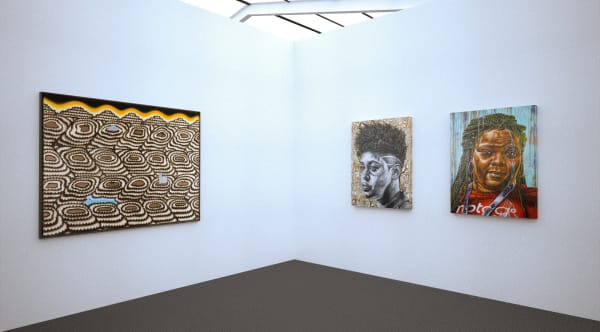
Frieze London 2020
9 - 16 Oct 2020FRIEZE LONDON ONLINE 2020 Kavi Gupta is proud to be part of Frieze London’s 2020 online viewing room. Innovative platforms like this offer us ways...Read more -
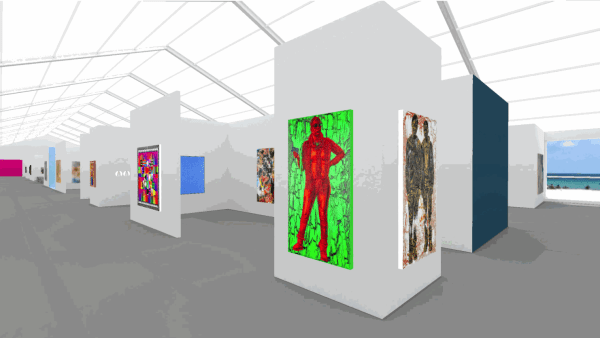
Untitled Art Fair Online 2020
30 Jul - 9 Aug 2020Kavi Gupta is proud to be a participating partner in UNTITLED, ART Online, the world's first VR art fair. Utilizing groundbreaking technology in unprecedented times,...Read more -
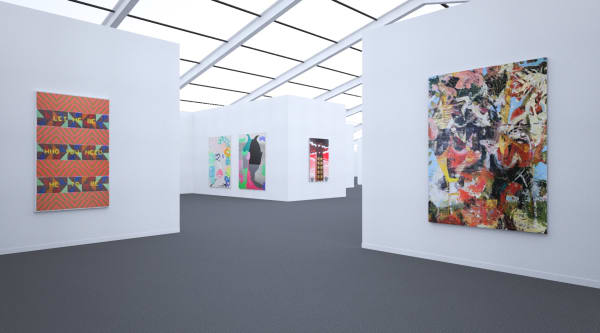
Frieze New York 2020
8 - 15 May 2020For Frieze New York 2020, Kavi Gupta welcomes you to an online presentation of extraordinary artworks from Jeffrey Gibson , Deborah Kass , Mary Sibande...Read more -
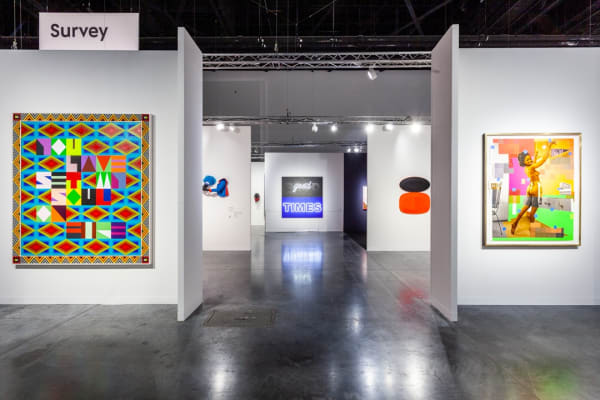
Art Basel Miami Beach 2019
4 - 8 Dec 2019Read more -

The Armory Show 2019
7 - 10 Mar 2019Kavi Gupta is thrilled to participate in the 2019 Armory Fair in New York City. Now in its 26th edition, The Armory Fair is a...Read more -

Frieze New York 2019
14 - 17 Feb 2019Kavi Gupta is pleased to participate in Frieze New York. Kavi Gupta Gallery will be located at Booth B22. For more information please contact 312-432-0708.Read more -

Art Basel Miami Beach 2018
6 - 9 Dec 20182018 has been a landmark year for AFRICOBRA (African Commune of Bad Relevant Artists), which was founded in Chicago in 1968 and defined the aesthetic...Read more -

The Armory Show 2018
8 - 11 Mar 2018For the Armory Show, Kavi Gupta will debut parts of our exciting 2018 program with a diverse selection of artists. Highlights will include works by...Read more
-

Closing Reception: Matter of Fact: Material as a Political Act
KAVI GUPTA | WASHINGTON BLVD. FL.2 10 Oct 2025Join us for the last opportunity to see Matter of Fact: Material as a Political Act. From our earliest exhibitions to the artists we continue...Read more -

Opening Reception: Matter of Fact: Material as a Political Act
KAVI GUPTA | WASHINGTON BLVD. FL.2 25 Apr 2025Join us for the opening reception of Matter of Fact: Material as a Political Act featuring director-led tours and refreshments to celebrate the opening of...Read more -
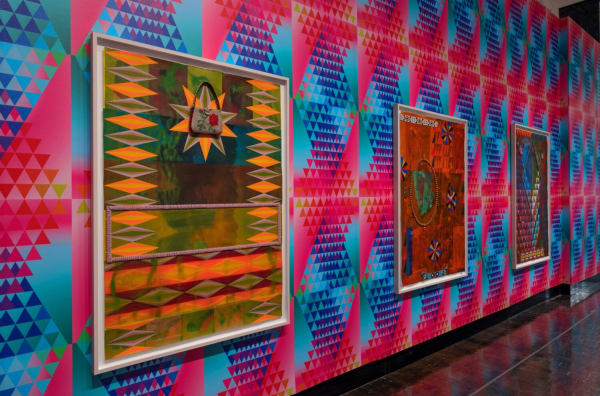
Gallery Talk: Jeffrey Gibson’s American Indian Abstract: Reclaiming Indigenous Art History
Frist Art Museum 13 Apr 2023Presented by Daniel H. Usner, PhD To what extent is Jeffrey Gibson’s work seen in The Body Electric influenced by aesthetic styles and historical subjects...Read more -

Jeffrey Gibson's: Copland Dance Episodes
New York 26 Jan - 16 May 2023UNIFYING THE VISUAL ARTS, MUSIC, AND DANCE, JUSTIN PECK CREATES HIS FIRST FULL-EVENING WORK After choreographing 22 works for New York City Ballet since 2012,...Read more -
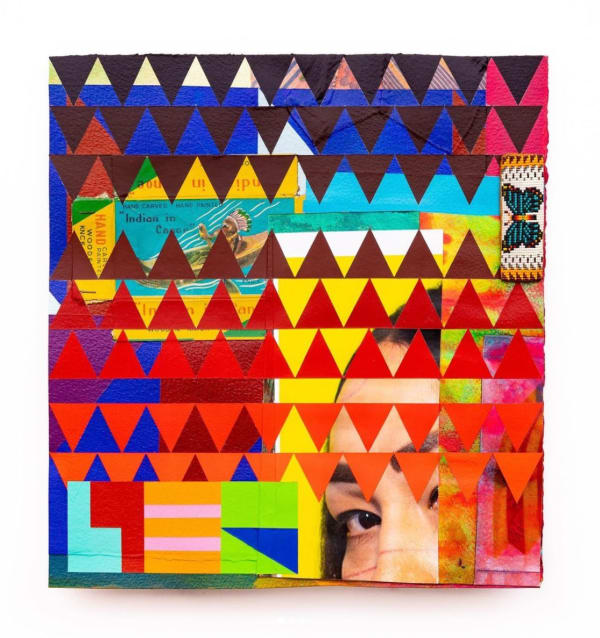
Jeffrey Gibson | Museum of Arts and Design Gala
Museum of Arts and Design, New York, NY 14 Nov 2022On Monday, November 14, beginning at 5:30 pm, the Museum of Arts and Design (MAD) will hold its annual MAD Ball gala at the Museum’s...Read more -

ArtCrush 2022
Aspen Art Museum, Aspen, CO 5 Aug 2022Jeffrey Gibson, Double Fortune , 2022 (detail). Printed cotton canvas, lyrca fabric, cotton thread, nylon thread, holographic vinyl fabric, acrylic felt, sculpting wire, acrylic druzy...Read more -
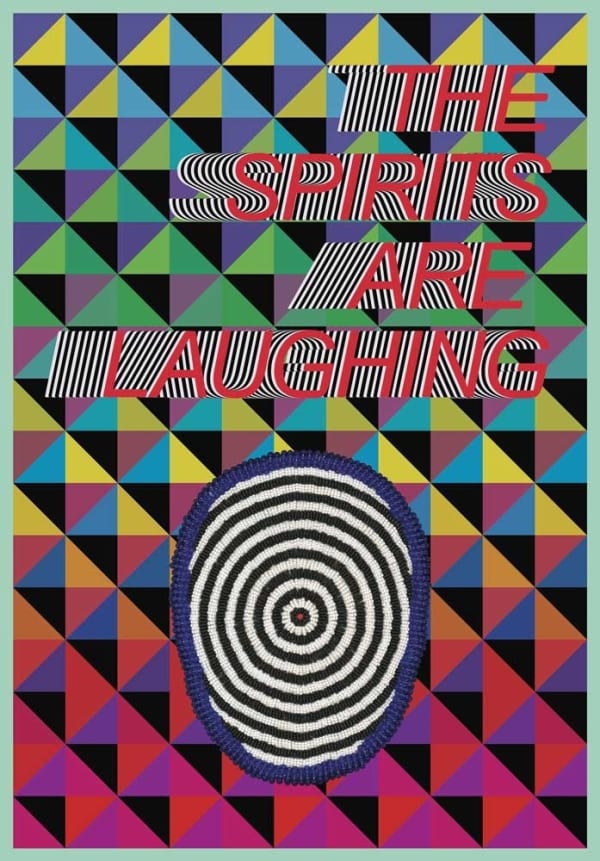
Jeffrey Gibson: THE SPIRITS ARE LAUGHING
Aspen Art Museum, Aspen, CO 3 Aug 2022Jeffrey Gibson presents THE SPIRITS ARE LAUGHING , an ambitious flag twirling and speaking performance at Anderson Park Meadow at the Aspen Institute. The live...Read more -

Reclaiming Narratives: Jeffrey Gibson and Nani Chacon in Conversation
SITE Santa Fe 8 May 2022Exhibiting artists Nani Chacon and Jeffrey Gibson will take the stage for a conversation about shared themes in their work, moderated by curator Brandee Caoba...Read more -
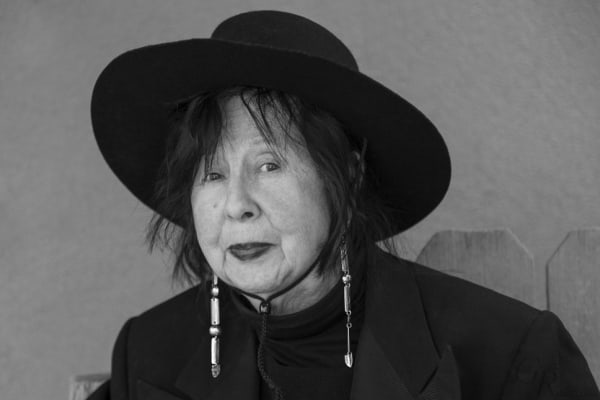
My Life in Art: Jeffrey Gibson and Jaune Quick-To-See Smith
SITE Santa Fe 7 May 2022As part of SITE Santa Fe’s opening weekend for the exhibition of Jeffrey Gibson: The Body Electric , Gibson will take the stage for a...Read more -

Creative Conversations: Jeffrey Gibson and Dyani White Hawk
28 Apr 2022Join the Museum of Contemporary Art Toronto on Thursday, April 28th from 7-8 PM EST for an online conversation featuring exhibiting artist, Jeffrey Gibson ,...Read more -

SÉANCE an Evening of Performances Hosted by Jeffrey Gibson and Ále Campos in Celebration of Beyond the Horizon
Kavi Gupta | 219 N Elizabeth St. 17 Dec 2021Kavi Gupta presents SÉANCE, an evening of music, art, performance and community in celebration of Jeffrey Gibson’s stunning solo exhibition Beyond the Horizon , hosted...Read more
-

Open Studio: Jeffrey Gibson
PBS | Open Studio with Jared Bowen June 3, 2022This week on Open Studio Jared Bowen kicks off Pride month by revisiting conversations he's had with artists like Jeffrey Gibson whose works look at...Read more -
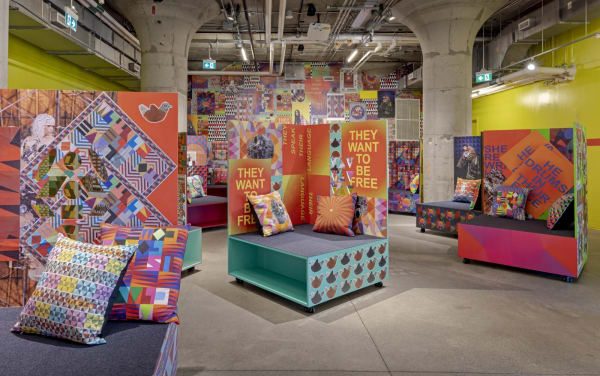
Spotlights: Jeffrey Gibson
MOCA Toronto May 6, 2022Jeffrey Gibson, a Member of the Mississippi Band of Choctaw Indians and Half Cherokee, is an interdisciplinary artist based in Hudson, New York. His artworks...Read more -
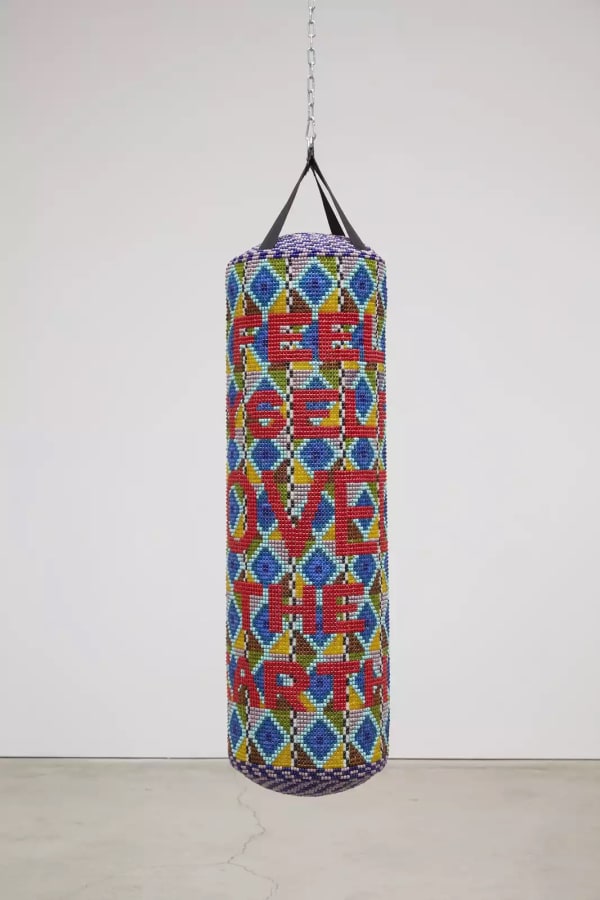
Jeffrey Gibson: Artist Talk, TO FEEL MYSELF BELOVED ON THE EARTH
The Contemporary Dayton March 9, 2022Choctaw-Cherokee artist, Jeffrey Gibson, is best known for his abstract painting, sculpture, and prints which carry an autobiographical cultural inflection. His video, To Feel Myself...Read more -
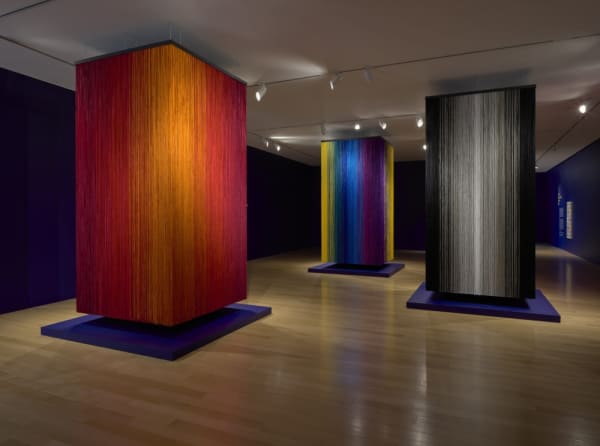
Jeffrey Gibson - Open Studio: Capturing queer love
March 2, 2022The latest episode of Open Studio with Jared Bowen looks at queer artists pushing boundaries and exhibits that are coming to a close. Jared sits...Read more -
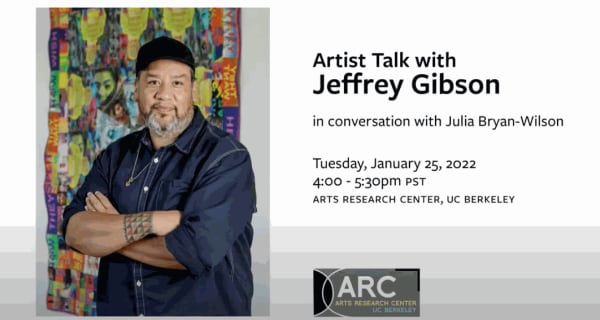
ARC Artist Talk with Jeffrey Gibson
January 25, 2022Read more -
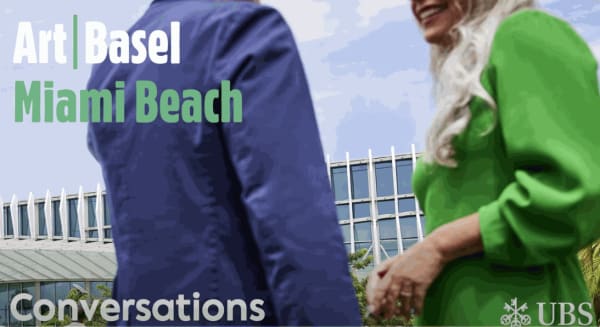
Jeffrey Gibson: Art Basel Miami Beach Conversations | Premiere Artist
December 16, 2021Read more -

IKC's Land Acknowledgment Atop Jeffrey Gibson's Monument at Socrates Sculpture Park
January 6, 2021Read more -

Jeffrey Gibson: Jingle Dance - Brooklyn Museum
November 23, 2020Read more -
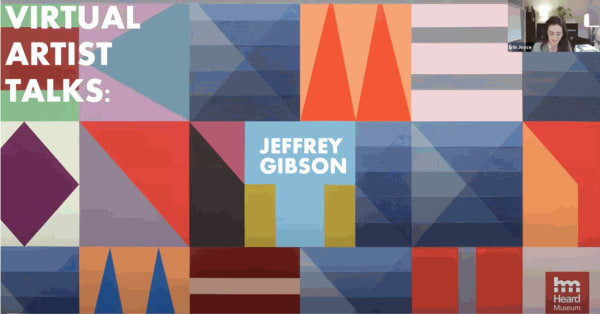
Heard Museum: Jeffrey Gibson artist talk
November 16, 2020Read more -
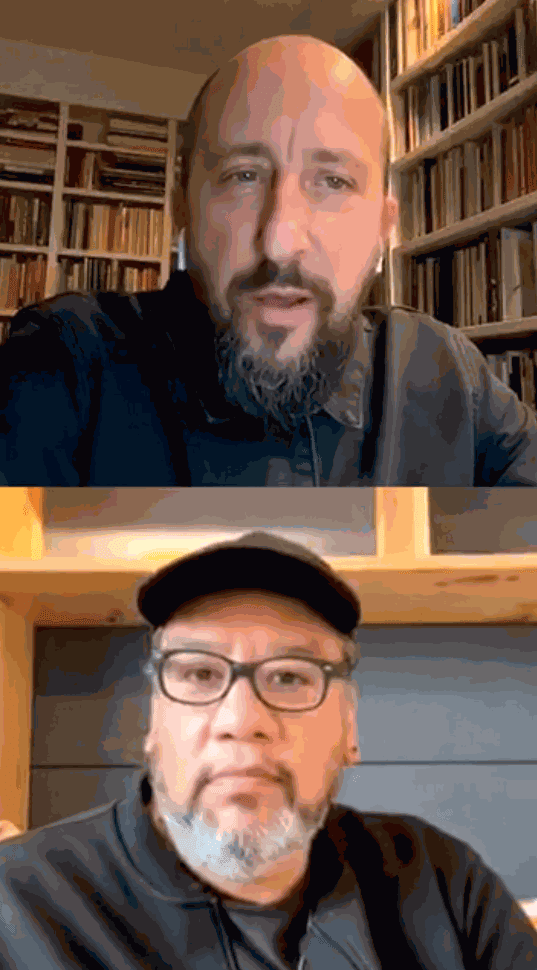
Jeffrey Gibson Daata Fair Live Instagram Q&A hosted by David Gryn
October 20, 2020Read more -
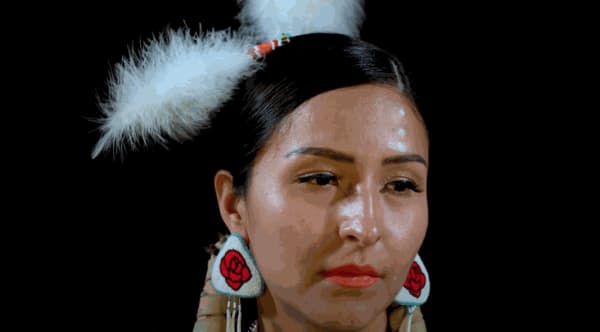
She Never Dances Alone by Jeffrey Gibson
August 16, 2020Read more -
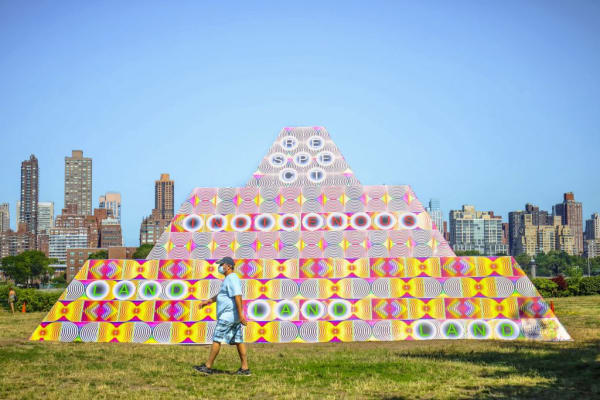
Jeffrey Gibson - Laura Ortman From Socrates Sculpture Park performance (Live Video)
August 1, 2020Read more -
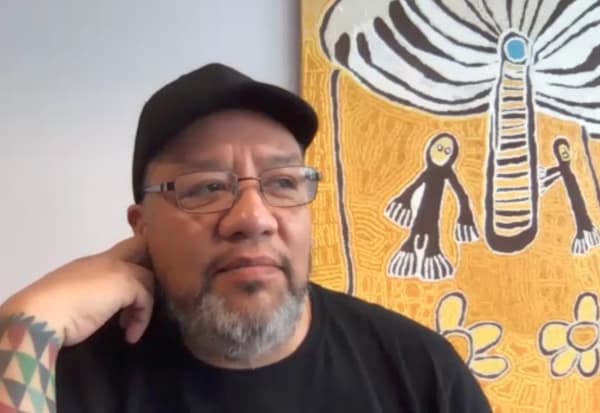
Art in Lockdown: Jeffrey Gibson
April 21, 2020Art in Lockdown interview with Jeffrey GibsonRead more -

Jeffrey Gibson, Visual Artist | 2019 MacArthur Fellow
September 25, 2019Read more -

Jeffrey Gibson: This Is the Day
Blanton Museum of Art | Austin, TX August 12, 2019Jeffrey Gibson: This Is the Day is a vibrant, celebratory contemporary art exhibition in which the artist brings together his Choctaw and Cherokee heritage and a range of diverse artistic and cultural influences to explore race, sexuality, religion, and gender. More than 50 recent works by Gibson include intricately beaded wall hangings and punching bags, paintings, ceramics, garments, helmets, and anew video commissioned for the exhibition, "I Was Here (2018)." Exuberant colors, patterns, and materials with text borrowed from pop culture combine to highlight unexpected connections between ceremonies and performances found in Native American powwow rituals, dance clubs, and drag shows, underscoring the complex vitality of Gibson's eclectic sources.Read more -

Blanton Museum of Art: Artist Conversation with Jeffrey Gibson
August 9, 2019Read more -
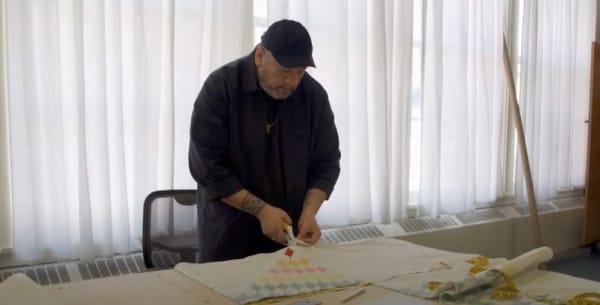
Meet the Artist: Jeffrey Gibson
Whitney Biennial 2019 June 3, 2019In the lead-up to the Whitney Biennial 2019, we visited five artists in their studios to learn more about their work. The first episode of...Read more -
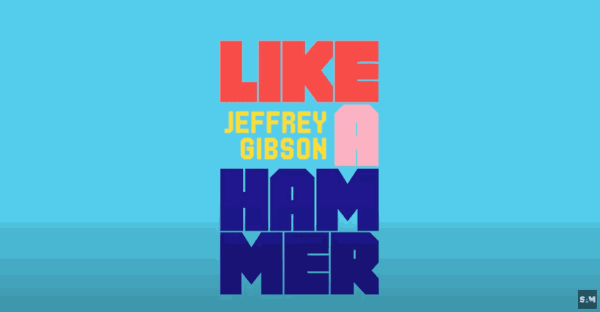
See Jeffrey Gibson: Like a Hammer at Seattle Art Museum
February 21, 2019Read more -
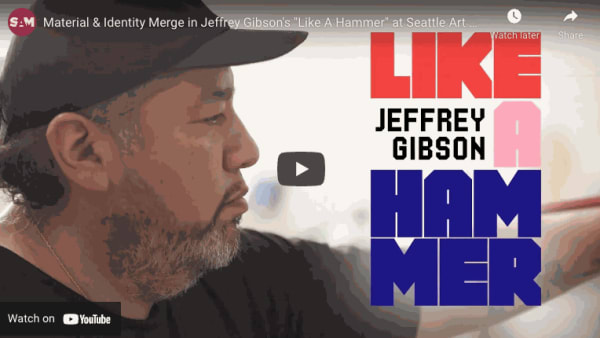
Jeffrey Gibson's "Like A Hammer" at Seattle Art Museum
January 31, 2019Read more -

Jeffrey Gibson: This Is the Day
August 7, 2018Read more -
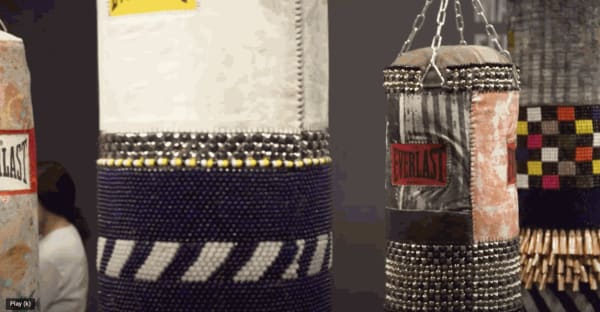
"Jeffrey Gibson: Like a Hammer" at the Denver Art Museum
June 12, 2018Read more -

Jeffrey Gibson | TED Talk | The exclusion of Native American art from the art world
January 29, 2018Read more -

School of Visual Arts Contemporary Perspectives Lecture with Jeffrey Gibson
December 9, 2016Read more -
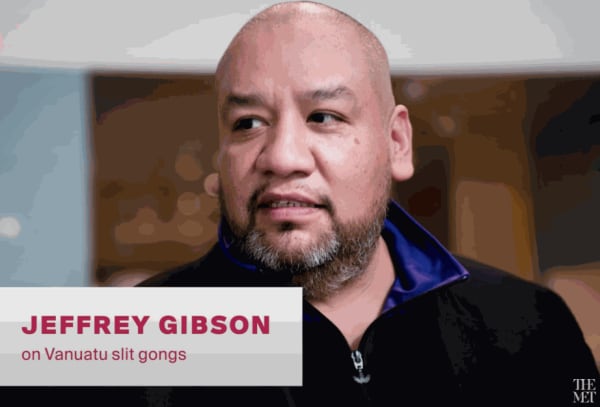
The MET Artist Project: Jeffrey Gibson
August 25, 2016Read more
-
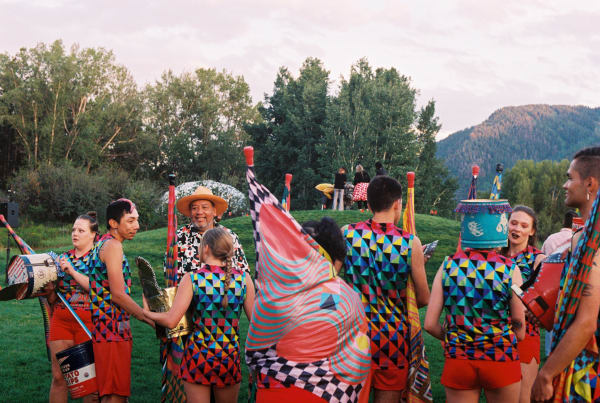
Jeffrey Gibson Speaks to the Spirits
Aspen Art Week 2022 August 6, 2022This past Wednesday, at 7,908 feet above sea level, Jeffrey Gibson spoke with the spirits. In THE SPIRITS ARE LAUGHING , Gibson’s recent performance as...Read more -
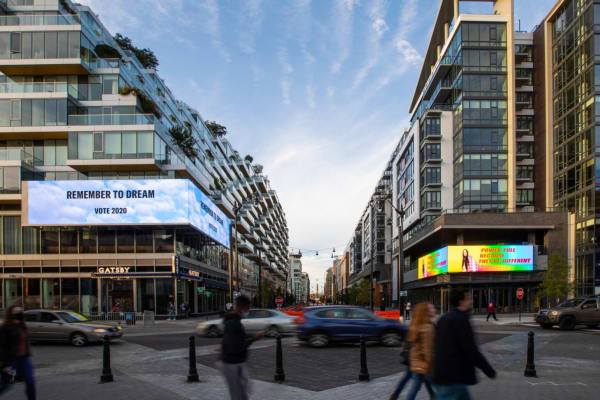
Jeffrey Gibson—Mobilizing Art For Action
October 17, 2020Along with other influential artists, including Jenny Holzer, Tomashi Jackson, and Carrie Mae Weems, Jeffrey Gibson has teamed up with Orange Barrel Media to take...Read more -

Jeffrey Gibson at Socrates Sculpture Park
August 1, 2020If you’re anywhere near Long Island City this autumn, be sure to make the trip to Socrates Sculpture Park to visit Jeffrey Gibson’s colorful, multi-tiered...Read more -
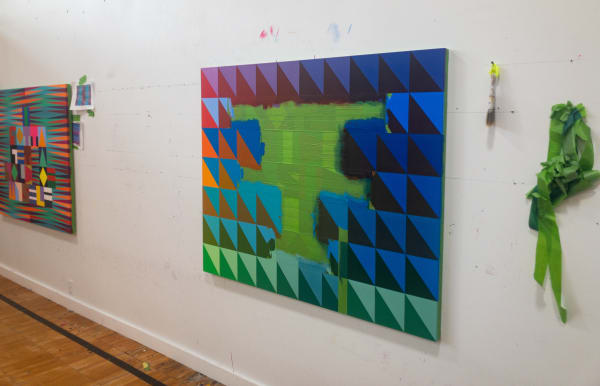
ART IN LOCKDOWN: JEFFREY GIBSON
04.29.2020Art in lockdown Jeffrey GibsonRead more -
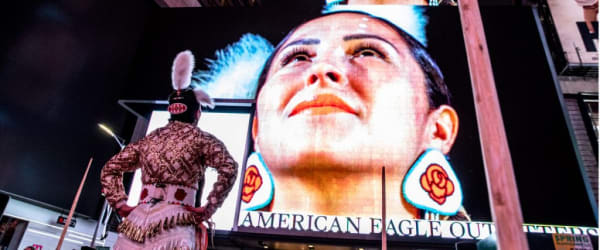
JEFFREY GIBSON’S SHE NEVER DANCES ALONE EXTENDED
04.29.2020JEFFREY GIBSON’S SHE NEVER DANCES ALONE EXTENDEDRead more -

THE WRITTEN WORD ONLINE EXHIBITION OPENS
04.24.2020The Written Word is an online exhibition examining the visual value of the verbal.Read more -
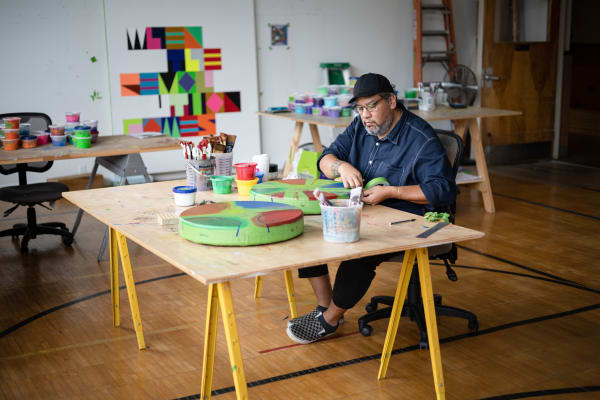
JEFFREY GIBSON WINS 2019 MACARTHUR “GENIUS GRANT”
09.25.19Kavi Gupta congratulates Jeffrey Gibson (b. 1972) on being awarded a 2019 John D. and Catherine T. MacArthur Fellowship. The gifts, which have come to be commonly known as MacArthur “Genius Grants,” are awarded each year by the John D. and Catherine T. MacArthur Foundation to highly creative individuals of the foundation’s choosing. This news comes on the heels of last weekend’s opening of CAN YOU FEEL IT, Gibson’s new solo show at Kavi Gupta.Read more -

JEFFREY GIBSON CURATED INTO 2019 WHITNEY BIENNIAL
02.27.2019Jeffrey Gibson in the Whitney BiennialRead more -

EXHIBITIONS TO SEE THIS FALL
09.12.18Fall 2018 Exhibitions featuring Jeffrey Gibson, Glenn Kaino, and Devan ShimoyamaRead more -

JEFFREY GIBSON: THIS IS THE DAY AT THE WELLIN MUSEUM OF ART
09.04.2018Jeffrey Gibson: This is the Day runs from September 8 through December 9, 2018. It is curated by Tracy L. Adler, Johnson-Pote Director of the Wellin Museum of ArtRead more -

CELEBRATING JEFFREY GIBSON IN DENVER
07.24.2018Hyperallergic review of Jeffrey Gibson's LIKE A HAMMER exhibition at the Denver Art Museum in 2018.Read more








